Funded articles
- Page Path
- HOME > Browse Articles > Funded articles
Research Articles
- [Korean]
- Analysis of the relationship between foodservice staffing and foodservice quality in elderly care facilities in Korea: a cross-sectional study
- Hyeonjeong Kim, Jinhee Kwon, Jungsuk Lee
- Korean J Community Nutr 2025;30(4):296-308. Published online August 29, 2025
- DOI: https://doi.org/10.5720/kjcn.2025.00122
- Funded: Ministry of Health and Welfare

-
 Abstract
Abstract
 PDF
PDF PubReader
PubReader ePub
ePub - Objectives
This study was performed to investigate the relationship between foodservice staffing and foodservice quality in elderly care facilities.
Methods
Data was obtained from the Korean Long-term Care Institute Database and used to analyze 2,084 elderly care facilities operating on-site foodservice. The presence of dietitians and staffing levels for cooking personnel were analyzed by categorizing size according to staffing criteria. Foodservice quality was assessed using food sanitation management and meal service provision as indicators. Descriptive statistical analysis, chi-square test, Fisher’s exact test, and Cochran-Mantel-Haenszel test were conducted to analyze relationships between staffing level and foodservice quality.
Results
Presence of a dietitian correlated with food sanitation management and meal service provision in groups with 30 or more recipients (P = 0.027, P = 0.049). Elderly care facilities with dietitians had better foodservice quality. After adjusting for size, the presence of dietitians was also found to correlate with food sanitation management (P = 0.024). Staffing levels for cooking personnel were found to correlate with meal service provision only in groups with 38 to 62 recipients. Institutions with larger staffs provided better meal service quality compared to those with basic staffing.
Conclusion
Inclusion of a dietitian and cooking staff size each contribute to enhanced foodservice quality in elderly care facilities, with dietitian inclusion showing a particularly significant association with food sanitation management. These findings suggest the need to revise current staffing and related regulatory standards to optimize deployment of foodservice personnel in elderly care settings. Future studies should focus on developing effective policies for securing qualified foodservice staff and establishing robust quality management systems to enhance overall foodservice quality in long-term care facilities.
- 279 View
- 12 Download

- [English]
- Associations between diet quality and regional factors in Korea vary according to individuals’ characteristics: a cross-sectional study
- Hyunmi Han, Clara Yongjoo Park, Jeonghwa Lee
- Korean J Community Nutr 2025;30(4):274-285. Published online August 29, 2025
- DOI: https://doi.org/10.5720/kjcn.2025.00157
- Funded: Korea Disease Control and Prevention Agency

-
 Abstract
Abstract
 PDF
PDF Supplementary Material
Supplementary Material PubReader
PubReader ePub
ePub - Objectives
Although diet quality is known to be associated with environment and individuals’ characteristics, these have not been studied together. We determined the association of diet quality with regional factors stratified by individuals’ sociodemographic characteristics.
Methods
This study used nationally representative survey data on regional factors (2010–2020) and the Korea National Health and Nutrition Examination Survey data on individuals’ sociodemographic characteristics (2013–2018). Community-dwelling Koreans aged ≥ 20 were included (n = 26,853). Regions were categorized into metropolitan cities or provinces and subsequently according to regional factors (level of educational attainment, income per capita, food security status, physical activity facilities, time to the nearest large retailer, and internet use of the region). Individuals’ sociodemographic characteristics included age, education status, income, and number of household members. Diet quality was assessed using the Korean Healthy Eating Index (KHEI).
Results
In the entire population, education status of metropolitan cities was positively associated with the KHEI. Shorter time to retailers and higher internet use were positively associated with the KHEI in metropolitan residents with higher income levels but negatively associated with the KHEI in those with lower income status. Among provincial residents with a low education status or income, regional physical activity facilities were positively associated with the KHEI.
Conclusion
The association between diet quality and regional factors varied depending on the resident’s sociodemographic characteristics. Both regional and individual sociodemographic factors must be considered to address gaps in nutritional equity.
- 348 View
- 11 Download

Research Note
- [English]
- Pilot evaluation of a cooking-based nutrition education program to promote vegetable intake among children in Seoul, South Korea: a single-group pre–post study
- Sil-Ah Kim, Su-Jin Lee, Min-Ah Kim, Ji-Eun Oh, Sohyun Park, Hyun-Joo Ryou, Ji-Yun Hwang
- Korean J Community Nutr 2025;30(4):249-260. Published online August 29, 2025
- DOI: https://doi.org/10.5720/kjcn.2025.00220
- Funded: National Research Foundation of Korea
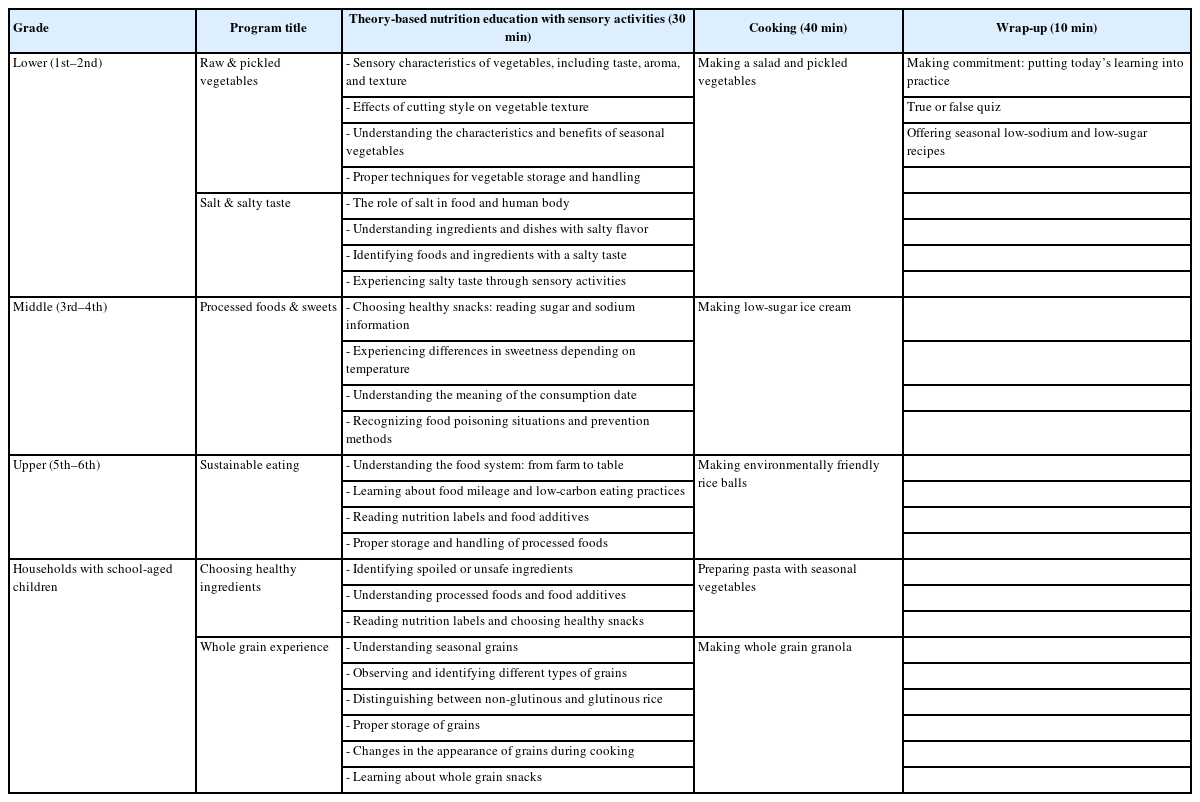
-
 Abstract
Abstract
 PDF
PDF PubReader
PubReader ePub
ePub - Objectives
Food neophobia in children is often associated with limited exposure and familiarity to some foods. Cooking-based nutrition education (CBNE), which promotes acceptance through direct experience, may support the development of healthy eating habits. This study aimed to develop and implement a standardized CBNE program for school-aged children in Seoul, South Korea, and to evaluate its effectiveness by assessing changes in raw vegetable intake. Raw vegetable intake is an early indicator of the effectiveness of nutrition education on diverse topics in promoting healthy eating habits.
Methods
A single-group pre–post study was conducted with 37 children aged 6–11 years who participated in a 2-day CBNE program in October 2023. The participants completed pre- and post-education questionnaires and raw vegetable intake assessments. Four low-preference vegetables (bell pepper, carrot, cucumber, and tomato) were selected and served raw (25 g each) before and after the program. Intake changes were analyzed using paired t-tests, and Pearson’s correlation and hierarchical regression analyses were performed to identify predictors.
Results
Total raw vegetable intake significantly increased post-education (P = 0.008), particularly for carrots (P = 0.023). By subgroup, raw vegetable intake significantly increased in girls, upper-grade students, and those who consumed four or more vegetable side dishes per meal. Hierarchical regression analysis revealed that while vegetable preference was initially significant, vegetable-related experiences (β = 0.395, P = 0.026) and diversity of vegetable side dishes per meal (β = 0.403, P = 0.032) were stronger predictors in the final model (adj R2 = 0.333).
Conclusion
The CBNE program may enhance vegetable intake in children. Although preference remained the strongest individual factor, vegetable experience and the diversity of vegetable side dishes per meal had a greater combined effect. These findings underscore the importance of repeated and diverse exposure, not only by supporting previous studies that link such exposure to increased intake but also by suggesting that environmental support may be essential for sustaining healthy eating habits.
- 465 View
- 23 Download

Research Article
- [Korean]
- Survey on consumer perceptions, health benefits and preferences of kindergarten and school foodservices in Korea, including related keywords reported in newspaper: a mixed-methods study
- Gyoungok Gang, Chaewon Park, Hyeja Chang
- Korean J Community Nutr 2025;30(4):309-320. Published online August 29, 2025
- DOI: https://doi.org/10.5720/kjcn.2025.00199
- Funded: Korea Educational Environments Protection Agency
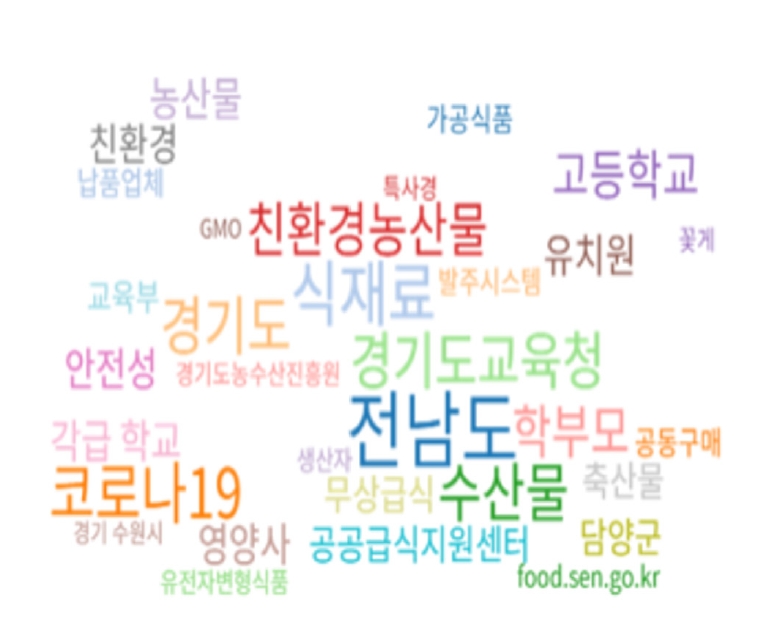
-
 Abstract
Abstract
 PDF
PDF PubReader
PubReader ePub
ePub - Objectives
With the rapid development of social culture, the perception of kindergarten and school foodservice, as well as opinions on its health benefits, has changed significantly. However, research on this topic remains scarce. We conducted a survey in South Korea on consumers’ perceptions, healthiness, and preferences regarding kindergarten and school foodservice.
Methods
With the nationwide cooperation of 17 city and provincial education offices, online and offline surveys were conducted targeting the parents of kindergarten and lower-grade elementary school children, as well as upper-grade elementary, middle, and high school students. In addition, keywords in newspaper reports were analyzed using the Big Kinds platform. A total of 532 valid questionnaires were collected, and statistical analysis was performed using IBM SPSS Statistics version 27.0 (IBM Co.).
Results
The average age of the parents and students was 40 and 12.5 years, respectively, with 36.4% of the students attending schools in the Seoul and Gyeonggi areas. The main keywords reported in newspaper articles, as analyzed using the Big Kinds platform, were “eco-friendly agricultural products,” “food ingredients,” “safety,” and “marine products.” The perception of kindergarten and school foodservice was very positive, especially regarding the attributes of safe ingredient use (4.44), menu variety (4.29), cafeteria cleanliness (4.31), cleanliness of plates, spoons, and utensils (4.24), thorough hygiene management (4.2), nutritional excellence (4.24), and support for proper eating habits (4.18). The healthiness of school foodservice was highly rated, although there is still room for improvement in terms of “not serving fried foods more than twice a week”. In terms of preference for school meals, the most preferred items were meat side dishes, followed by chicken, noodles, fried food, beverages, and bread. In contrast, soybean paste soup, vegetables, and mixed-grain rice received relatively low preference.
Conclusion
The results described above may be used to develop educational programs or policies that inform students and parents about the goals of school foodservice and help address common misunderstandings.
- 452 View
- 13 Download

Review
- [Korean]
- Current status of nutrition education media and its utilization in providing customized nutrition information for older adults in Korea: a scoping review based on the transtheoretical model and food literacy
- Seojin Yun, Jiwon An, Kirang Kim
- Korean J Community Nutr 2025;30(3):175-182. Published online June 30, 2025
- DOI: https://doi.org/10.5720/kjcn.2025.00094
- Funded: National Research Foundation of Korea

-
 Abstract
Abstract
 PDF
PDF Supplementary Material
Supplementary Material PubReader
PubReader ePub
ePub - Objectives
This study analyzes the status of nutrition education media among Korean older adults based on the transtheoretical model (TTM) and their food literacy to propose effective strategies for the development and utilization of educational media.
Methods
A literature review was conducted using The Joanna Briggs Institute (JBI) protocol. The literature search was performed using government and local government agency websites, as well as those of affiliated institutions, health and nutrition-related academic societies, and academic search engines. A total of 144 studies were identified, and after a cross-evaluation by two reviewers based on the literature selection criteria, 73 studies were included in the final analysis.
Results
Among the types of nutrition education media, card news had the highest proportion, followed by video media. The development and distribution of nutrition education media for older adults were primarily carried out by government and local government agencies, as well as related affiliated institutions, accounting for 80.8% (n = 59) of the total. When nutrition education topics in the media were categorized according to the stages of behavior change in the TTM, the largest proportion, 64.6% (n = 61), was applicable to the precontemplation and contemplation stages. When categorized by food literacy domains, all topics fell under the categories of nutrition and safety.
Conclusion
Nutrition education media for older adults were found to be primarily focused on knowledge acquisition and information delivery, making them mostly applicable to the precontemplation and contemplation stages of behavior change. The concept of food literacy addressed in the different types of media was limited to the domains of nutrition and safety, with no content covering the cultural and relational domains or the social and ecological domains. For tailored nutrition education, it is necessary to develop diverse educational materials that comprehensively reflect each stage of the TTM and all aspects of food literacy.
- 1,085 View
- 62 Download

Research Articles
- [English]
- The impact of flash continuous glucose monitoring and nutrition coaching on dietary self-efficacy and weight management in university students in Korea: a pre-post intervention study
- Soojin Park
- Korean J Community Nutr 2025;30(3):183-196. Published online June 30, 2025
- DOI: https://doi.org/10.5720/kjcn.2025.00073
- Funded: Semyung University
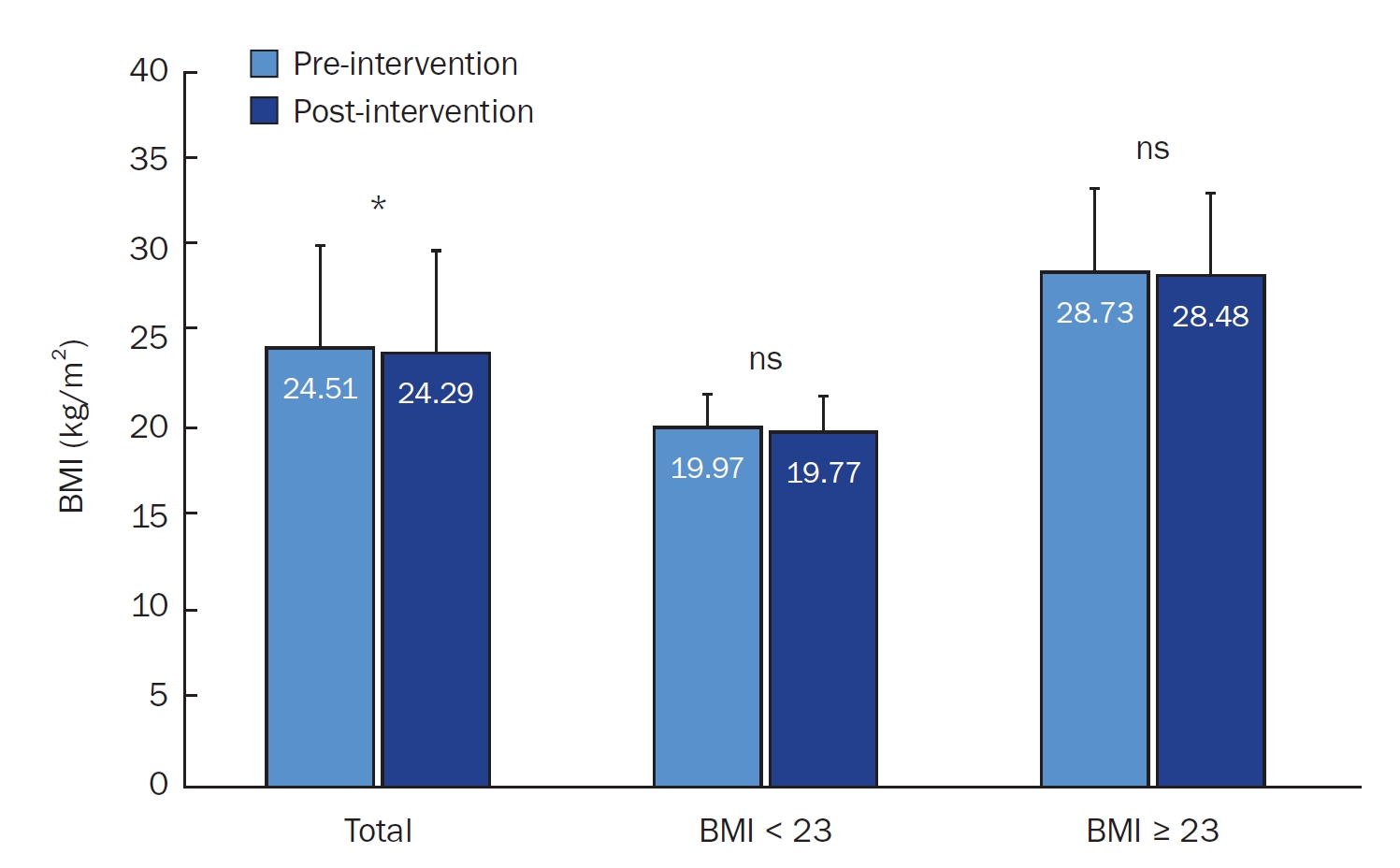
-
 Abstract
Abstract
 PDF
PDF PubReader
PubReader ePub
ePub - Objectives
This study aimed to evaluate the impact of a 4-week multicomponent intervention combining flash continuous glucose monitoring (flash-CGM), group nutrition education, and personalized nutrition coaching on dietary self-efficacy (DSE) and weight management in healthy university students.
Methods
A total of 27 university students participated in a pre-post intervention study. The intervention included a single 4-hour group-based nutrition education session, flash-CGM usage (FreeStyle Libre; Abbott Diabetes Care), and weekly one-on-one nutrition coaching. Participants wore the CGM device for 28 days (replaced after 14 days), and were guided in using the FoodLens app (DoingLab) for dietary tracking and a mobile app-linked digital scale for weight monitoring. Outcomes measured before and after the intervention included DSE, body mass index (BMI), nutrition quotient (NQ) and glycemic indicators. Statistical analyses included Wilcoxon signed-rank and Mann-Whitney U-tests with significance set at P < 0.05.
Results
There was a significant increase in DSE (P < 0.05), particularly in managing eating behavior under stress and fatigue. A modest but significant decrease in BMI was observed in the overall group (P < 0.05), though changes were not significant in the BMI ≥ 23 kg/m2 subgroup. Glycemic indicators showed minimal changes. The overall NQ score improved slightly, with significant increases in fruit intake (P < 0.01) and nutrition label checks (P < 0.05). High satisfaction levels (4.52 ± 0.65 on a 5‑point scale) were reported for device usability and coaching services.
Conclusion
The multicomponent intervention improved DSE, NQ scores, and supported modest weight reduction among university students. The combined effect of CGM, nutrition education, and coaching appears promising; however, further studies are needed to isolate the effects of each component and evaluate long-term outcomes. Trial Registration: Clinical Research Information Service Identifier: KCT0010255.
- 814 View
- 19 Download

- [English]
- The dietary factors associated with sleep duration in postmenopausal middle-aged women: a cross-sectional study using 2019–2023 Korea National Health and Nutrition Examination Survey data
- Eugene Shim
- Korean J Community Nutr 2025;30(3):197-213. Published online June 30, 2025
- DOI: https://doi.org/10.5720/kjcn.2025.00052
- Funded: Soongeui Women’s University

-
 Abstract
Abstract
 PDF
PDF PubReader
PubReader ePub
ePub - Objectives
This study aimed to analyze dietary factors associated with sleep duration in postmenopausal middle-aged women using data from the Korea National Health and Nutrition Examination Survey (KNHANES), with particular emphasis on the postmenopausal period.
Methods
A total of 3,040 postmenopausal women aged 40–64 years from the 2019–2023 KNHANES were included. Sleep duration was classified into four categories: “appropriate sleep duration” (ASD; 7–9 hours), “short sleep duration” (6–7 hours), “very short sleep duration” (VSSD; < 6 hours), and “long sleep duration” (LSD; > 9 hours). Nutrient and food intake were compared among groups using analysis of covariance. Multinomial logistic and polynomial regression models assessed associations, adjusting for demographic and health covariates.
Results
The VSSD group had higher body mass index and waist circumference than the ASD group, despite lower total energy intake, and also consumed more snack energy and skipped breakfast and dinner more often. This group also had lower intakes of monounsaturated fatty acids and nuts and seeds. In the late menopausal group, greater consumption of cereal grains, fish and shellfish, and beverages was associated with elevated LSD risk. Conversely, higher folate intake in the early menopausal group was inversely associated with VSSD risk. Cholesterol intake was positively associated with LSD risk in both groups. A negative nonlinear association between sleep duration and dietary intake was observed in the early menopausal group when polyunsaturated fatty acid intake exceeded 19.86 g/day and riboflavin intake exceeded 1.76 mg/day. In the late menopausal group, riboflavin intake was strongly correlated with increased LSD risk (odds ratio = 4.776, P = 0.004). Sugar and beverage intake showed a positive linear relationship with sleep duration at average intake levels.
Conclusion
Dietary factors associated with sleep duration differed by postmenopausal period, with specific nutrients and food groups exhibiting variable associations with sleep duration above mean intake levels.meS
- 1,884 View
- 26 Download

- [Korean]
- Behavioral intention toward planetary health diet among adult users of government worksite cafeterias in Seoul, South Korea: a mixed-methods study based on the theory of planned behavior and focus groups interviews
- Ji-Won Kang, Su-Jin Lee, Sil-Ah Kim, Ji-Yun Hwang
- Korean J Community Nutr 2025;30(3):224-236. Published online June 30, 2025
- DOI: https://doi.org/10.5720/kjcn.2025.00108
- Funded: National Research Foundation of Korea
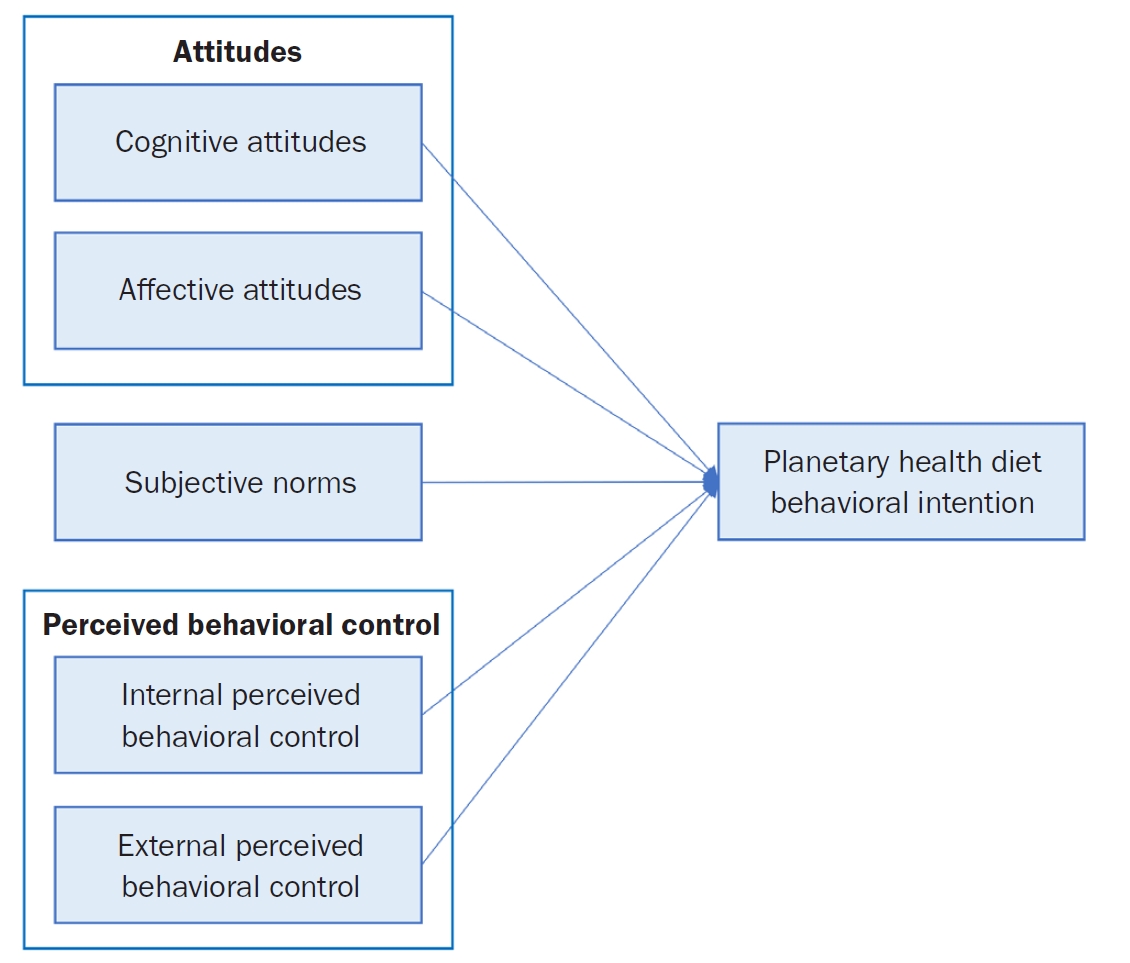
-
 Abstract
Abstract
 PDF
PDF PubReader
PubReader ePub
ePub - Objectives
To reduce urban carbon emissions, in this study, we aimed to suggest strategies for disseminating the planetary health diet (PHD) guidelines to adult cafeterias in a government worksite in Seoul based on the theory of planned behavior (TPB) and focus group interviews (FGI).
Methods
A total of 132 adults who worked at a government worksite in Seoul and used its cafeteria were included for a TPB-based survey. Factor analyses and multiple regression were used to investigate the relationships between attitude (cognitive•affective), subjective norms, and perceived behavioral control (PBC, internal•external) and the behavioral intention to adopt the PHD. To identify the contextual factors related to PHD dissemination, 14 participants underwent in-depth interviews.
Results
Affective attitudes and PBC (internal•external) constructs of the TPB were significantly related with the intention to adopt PHD: external PBC (β = 0.324, P < 0.001), internal PBC (β = 0.269, P < 0.01), and affective attitudes (β = 0.226, P < 0.05). The FGI results highlighted the insufficiency of simply providing healthy meals to encourage the adoption of PHDs, but that menu development and natural acceptance strategies are needed to increase palatability. In addition, the need for strategies to promote PHDs at an organizational level was identified, as it is directly influenced by the company of partners with whom one dines. Furthermore, users' perceptions of how “Meals for the Planet” are delivered and suggestions for its improvement were also interpreted.
Conclusion
Our results suggest that users' beliefs, convictions, and emotions are important while promoting or educating individuals about sustainable PHDs. Our findings are expected to help local governments or private group cafeterias that wish to introduce PHDs in the future, given the growing importance of environmentally conscious eating.
- 674 View
- 47 Download

- [English]
- Shifting social perceptions of dietitians in Korea after the legislation of nutrition teachers: a keyword network analysis of unstructured data
- Yunkyoung Oh, Eunsil Her
- Korean J Community Nutr 2025;30(3):214-223. Published online June 30, 2025
- DOI: https://doi.org/10.5720/kjcn.2025.00045
- Funded: Changshin University
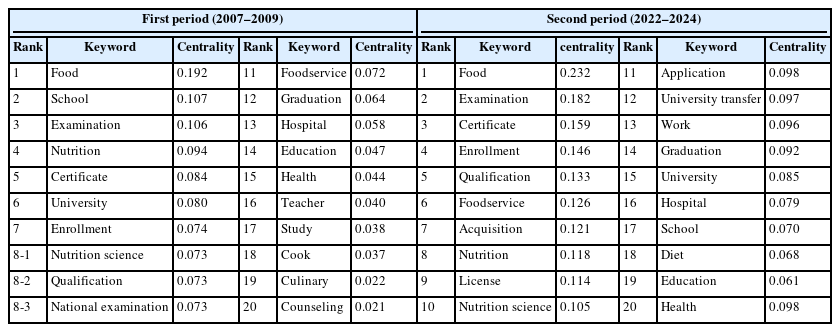
-
 Abstract
Abstract
 PDF
PDF PubReader
PubReader ePub
ePub - Objectives
In Korea, dietitian licenses began to be issued in 1964, and they have been working to prevent diseases and promote people’s health in various fields according to the times. This study was conducted to compare differences in social perception of dietitian over time by collecting online unstructured data and analyzing the frequency and network structure of nutritionist-related keywords after the deployment of nutrition teachers began.
Methods
Using ‘dietitian’ as a keyword, we collected data from NAVER’s web, blogs, and news provided by Textom (2024, The IMC) and refined the data. We investigated the frequency ranking of keywords related to dietitians for each period, revealed the network structure using UCINET6 (Freeman) and Netdraw, and clustered similar concepts among keywords through CONCOR (CONvergence of iterated CORrelations) analysis to cluster-related concepts.
Results
Frequency analysis revealed that during the first period, keywords such as “School” and “Education” reflecting the institutionalization of nutrition teachers, were highly ranked. However, by the second period, these terms had dropped out of the top 10. Meanwhile, keywords related to healthcare, such as “Hospital”, consistently remained among the most prominent. In the second period, the rankings of the “License” and “University transfer” keywords increased significantly. Centrality analysis showed stronger connectivity between dietitians and keywords such as “Food”, “School”, “Examination”, and “Nutrition” in the second period compared to the first. CONCOR analysis further demonstrated that the “Major education” cluster of the first period was differentiated into the “Major education and qualification” and “professional competency certification process” clusters of the second period. In addition, the “Health and welfare” cluster of the first period was divided into the “Health and welfare regional service” clusters of the second period.
Conclusion
The results of this study will be used as basic data for identifying social perception and trends in the dietitian profession, further providing a scope for their improvement.
- 1,053 View
- 17 Download

- [English]
- Comparison of clinical characteristics and dietary intakes according to phenotypes of type 2 diabetes mellitus in South Korea: a cross-sectional study
- Mi-Jin Kim, Ji-Sook Park, Sung-Rae Cho, Daeung Yu, Jung-Eun Yim
- Korean J Community Nutr 2025;30(2):127-139. Published online April 29, 2025
- DOI: https://doi.org/10.5720/kjcn.2025.00059
- Funded: National Research Foundation of Korea
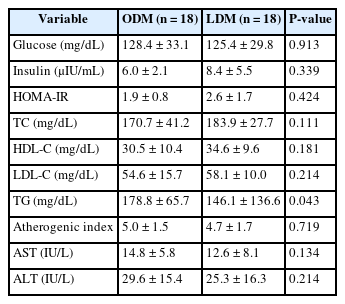
-
 Abstract
Abstract
 PDF
PDF PubReader
PubReader ePub
ePub - Objectives
Clinical nutrition treatment is the central part of diabetes management, such as prevention, treatment, and self-management of diabetes, and personalized clinical nutrition treatment, which enables improvement in patients with type 2 diabetes mellitus (T2DM). Our study aimed to contribute to the improvement of appropriate nutrition management in personalized treatment for obese and non-obese diabetes patients.
Methods
T2DM patients were recruited as participants, and 36 final participants were assigned to the lean diabetes mellitus group (LDM; body mass index [BMI] < 25 kg/m2) and the obese diabetes mellitus group (ODM; BMI ≥ 25 kg/m2). We assessed the dietary intakes, body composition, dietary habits, the Korean version of obesity-related quality of life, and biochemical indices.
Results
According to the phenotype’s comparison, the ODM group had a high prevalence of T2DM complications and hypertension, had a dietary habit of less than 10 minutes of mealtime duration and preferred fast food intake, and had a low obesity-related quality of life. However, the LDM group had a high choice of Korean dishes at the time of eating out and a high intake of vitamin C, and iodine because of the intake of vegetables and seaweeds.
Conclusion
We observed differences in diet, nutrient intake, and clinical characteristics according to the phenotype of T2DM patients. In particular, obese diabetes patients have an increased risk of cardiovascular diseases, bad dietary habits, and low obesity-related quality of life. Therefore, personalized nutrition treatment is needed in consideration of the risk of cardiovascular disease and dietary habits for patients in the ODM group, as well as determining the energy requirements of Korean patients with T2DM.
- 859 View
- 28 Download

- [English]
- Healthy eating intentions among adults in China: a cross-sectional study of northern and southern regions and city tiers based on the theory of planned behavior
- Yi Jiang, Ji-Yun Hwang
- Korean J Community Nutr 2025;30(2):114-126. Published online April 29, 2025
- DOI: https://doi.org/10.5720/kjcn.2025.00087
- Funded: National Research Foundation of Korea, National Research Foundation of Korea
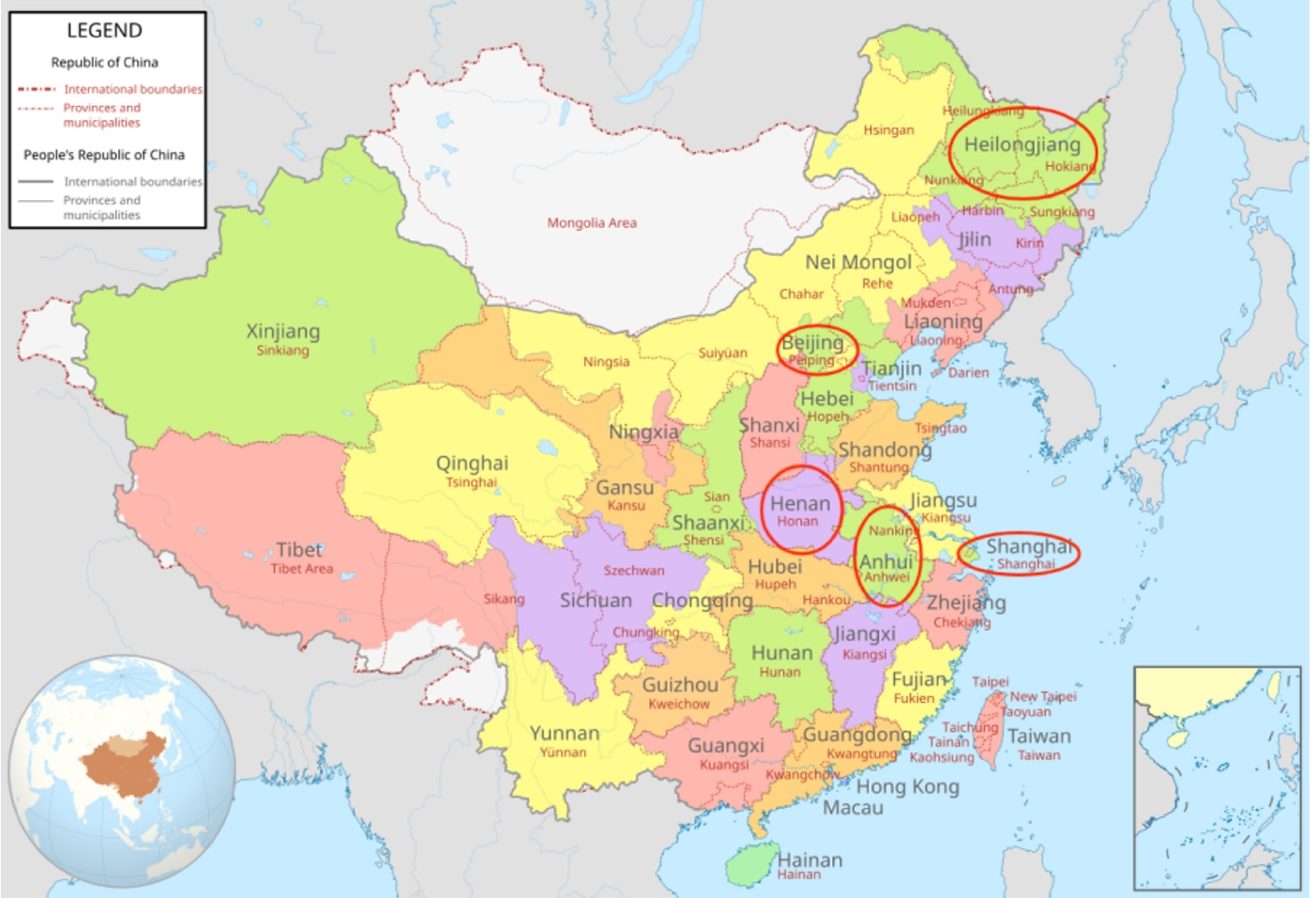
-
 Abstract
Abstract
 PDF
PDF PubReader
PubReader ePub
ePub - Objectives
The theory of planned behavior (TPB) has been widely employed to predict healthy eating intentions. Regional differences may affect dietary habits, health status, and personality traits, whereas variations in urbanization influence accessibility to fresh and healthy food, thereby impacting TPB components. This study aimed to explore whether regional differences between northern and southern China including city-tier development are associated with healthy eating intentions among Chinese adults.
Methods
The study included data from 2,114 Chinese adults aged 19–64 years collected between 2019 and 2023. Participants were categorized by geographic region (north or south) and city-tier status (first-tier or other).
Results
Compared to individuals from northern first-tier cities, those from southern regions exhibited stronger attitudes, perceived behavioral control (PBC), and intention to eat healthily. Participants from other cities in the north had more positive attitudes, subjective norms, PBC, and intentions to participate in healthy eating. Furthermore, residents of southern cities revealed weaker subjective norms than those of cities in the north. The adjusted odds ratio (OR) for compliance with intention to engage in healthy eating was higher among participants from other cities in both the north and south compared to those from northern first-tier cities (northern other cities: OR = 2.43, 95% confidence interval [CI]: 1.49–3.97, P < 0.001; southern other cities: OR = 1.95, 95% CI: 1.08–3.51, P = 0.027). No significant differences existed among the subjects from first-tier cities according to their geographic regions. These trends remained consistent even after including the interaction term between geographic regions and city-tier classification.
Conclusion
These findings underscore the complexity of regional variations influencing dietary intentions and indicate that tailored health promotion strategies should incorporate regional characteristics. Future research should explore underlying factors, including regional cultural influences, to better inform policies and interventions. -
Citations
Citations to this article as recorded by- Beyond taste: Unpacking the drivers of plant-based diet adoption
Md. Asaduzzaman Babu
Food and Humanity.2025; 5: 100779. CrossRef
- Beyond taste: Unpacking the drivers of plant-based diet adoption
- 950 View
- 23 Download
- 1 Crossref

- [Korean]
- A study on regional differences in dietary behaviors and satisfaction in Korea focusing on urban and rural comparisons: a cross-sectional study
- Jong-Youn Rha, Sohyun Kim, Hae-Rang Lee, Juhyeon Kil
- Korean J Community Nutr 2025;30(2):140-149. Published online April 29, 2025
- DOI: https://doi.org/10.5720/kjcn.2024.00262
- Funded: Agriculture Science and Technology Development
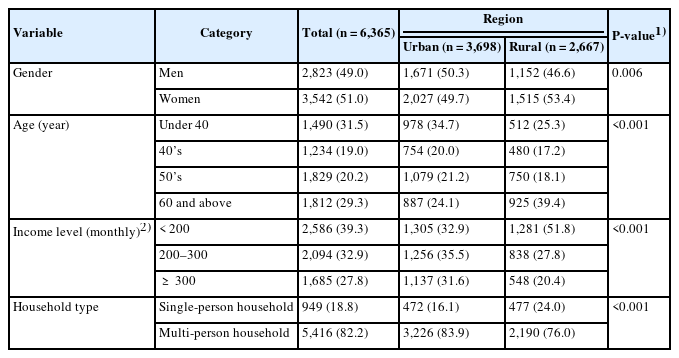
-
 Abstract
Abstract
 PDF
PDF PubReader
PubReader ePub
ePub - Objectives
This study aims to examine regional differences in dietary behavior and satisfaction between urban and rural residents in Korea, identifying key factors associated with dietary satisfaction in each group to deepen understanding of these variations.
Methods
The data were obtained from the Consumer Behavior Survey for Food 2022 by the Korea Rural Economic Institute. The analysis involved 6,365 adult participants, using the complex survey χ2-test and complex survey t-tests to compare dietary behavior across regions and complex survey regression analysis to explore factors related to dietary satisfaction. Data were analyzed with R 4.3.1 (for macOS; Posit PBC).
Results
Urban and rural areas differed in consumer characteristics such as gender, age, income, and household type, as well as in food consumption behaviors and in dietary competencies associated with purchasing and intake. Specifically, dining out and processed food consumption were more prevalent in urban areas, whereas home-cooked meals were more frequent in rural areas. Overall, dietary competencies were higher among urban residents. However, there was no significant difference in dietary satisfaction between the two regions. This finding suggests that satisfaction is based on subjective evaluations, with consumers in each region forming satisfaction in ways that align with their environment and lifestyle. Accordingly, the factors contributing to dietary satisfaction differed by region. In urban areas, information utilization competency and maintaining a balanced diet played a significant role in dietary satisfaction, whereas in rural areas, regular mealtimes were more influential. Urban consumers reported higher dietary satisfaction when meals provided a sense of appropriate convenience, whereas rural consumers showed greater satisfaction when meals were shared with family at home.
Conclusion
The findings indicate regional differences in food consumption behaviors and dietary competencies, as well as variations in how consumers achieve dietary satisfaction. These insights provide a foundation for developing dietary policies and programs aimed at improving dietary satisfaction.
- 1,022 View
- 44 Download

- [Korean]
- Application of a living lab model to an evidence-based reduced-sodium healthy eating practice program in Korea: a pre-post study
- Jung-Hyun Kim, Eugene Shim, Min Sook Kyung, Sooyoun Kwon, Hyoung Su Park, Jae-Heon Kang
- Korean J Community Nutr 2025;30(1):53-63. Published online February 28, 2025
- DOI: https://doi.org/10.5720/kjcn.2024.00346
- Funded: National Institute of Food and Drug Safety Evaluation, National Institute of Food and Drug Safety Evaluation
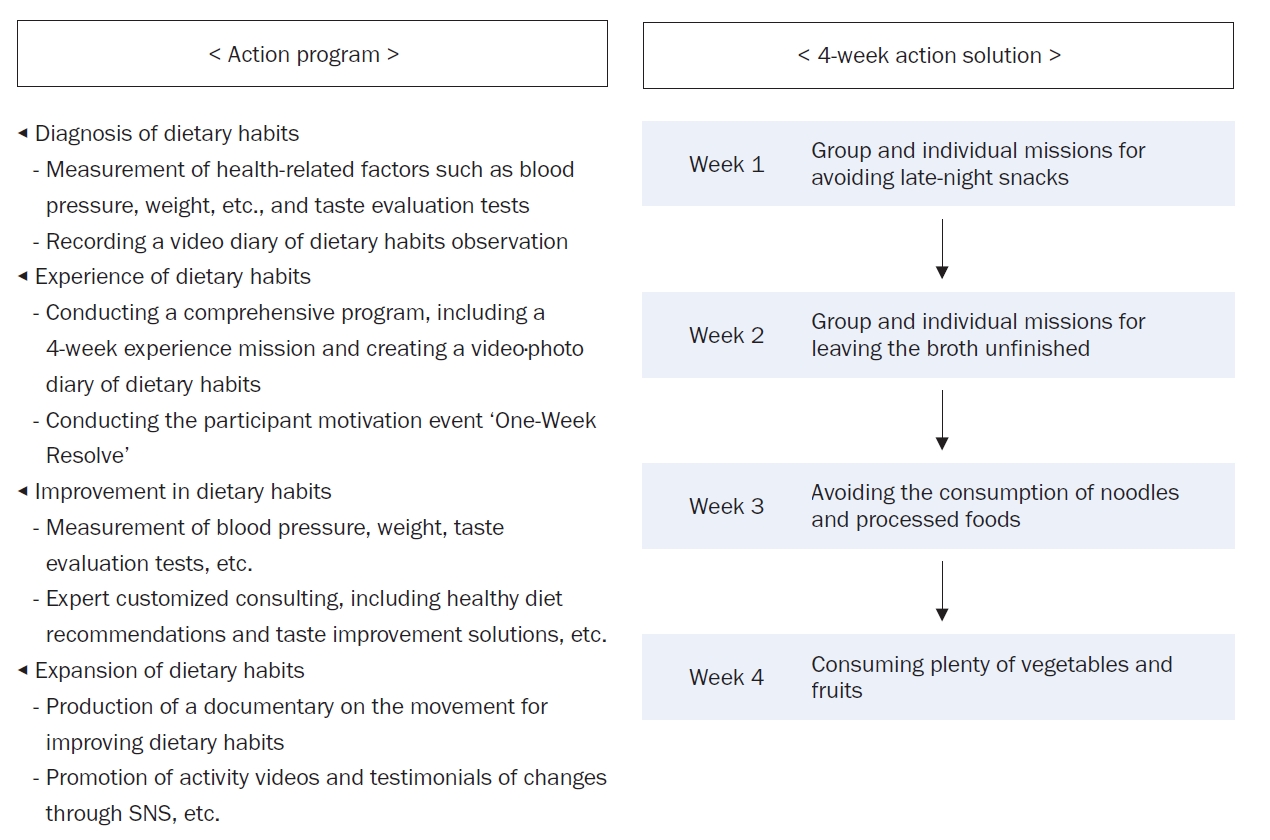
-
 Abstract
Abstract
 PDF
PDF PubReader
PubReader ePub
ePub - Objectives
To apply a healthy dietary program with reduced sodium intake, developed using data from the Korea National Health and Nutrition Examination Survey (KNHANES), focusing on the sodium intake level and eating patterns.
Methods
The program was implemented using a living lab model, an open innovation ecosystem for user-centered problem-solving. Analysis of the KNHANES data revealed that older age groups had a low energy intake but a high sodium intake, particularly among those who frequently dined out. The program was designed to improve sodium-reduction literacy and enhance practical competency. Over four weeks, 40 participants tracked their dietary intake and worked with a clinical nutritionist through a process of diagnosis, experience, improvement, and expansion. A self-administered survey was conducted before and after the program to assess effectiveness.
Results
Participants were four teenagers (10%), 26 in their twenties (65%), and 10 aged ≥ 30 years (25%), with eight males (20%) and 32 females (80%). Post-program analysis showed significant improvements in sodium-related nutrition knowledge (P < 0.01), with increased agreement on adopting low-sodium intake practices (e.g., interest in sodium content, choosing lower-sodium foods). Nutrient intake analysis showed a decrease in energy, carbohydrates, lipids, and proteins (P < 0.001), with sodium intake decreasing from 3,382.37 mg/d to 2,119.05 mg/d (P < 0.001).
Conclusion
The community-based, living lab model for the sodium-reduction program effectively improved participant sodium-reduction literacy and practical competency, suggesting that step-by-step, autonomous learning, can reduce sodium intake and promote healthier eating habits.
- 1,282 View
- 45 Download

- [English]
- Food and nutrient intake in pregnant women with singletons or multiples and post-delivery changes in intake in Korea: an observational study
- Cheawon Lee, Dahyeon Kim, Yoon Ha Kim, Myeong Gyun Choi, Jong Woon Kim, Clara Yongjoo Park
- Korean J Community Nutr 2025;30(1):1-15. Published online February 28, 2025
- DOI: https://doi.org/10.5720/kjcn.2024.00325
- Funded: National Research Foundation of Korea, Chonnam National University
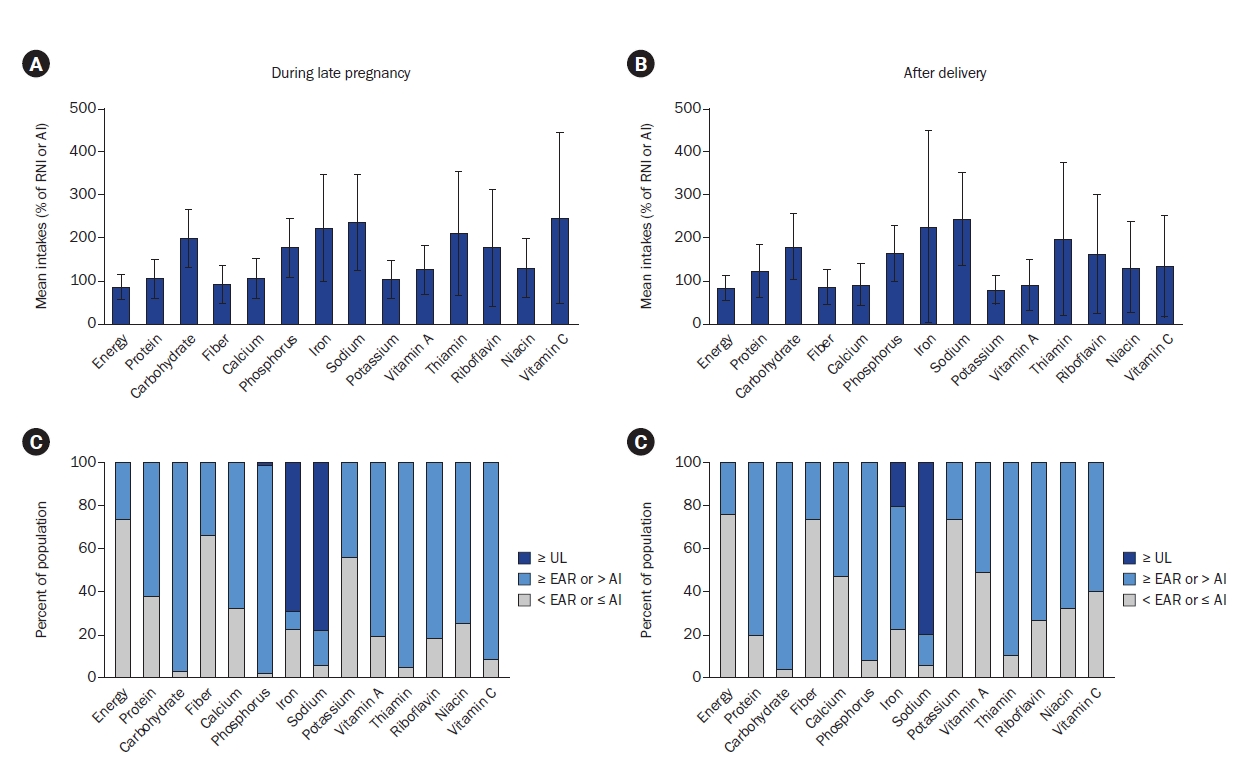
-
 Abstract
Abstract
 PDF
PDF Supplementary Material
Supplementary Material PubReader
PubReader ePub
ePub - Objectives
Nutrient intake during pregnancy and lactation is crucial for the health of both mother and offspring. Diet and nutrient metabolism potentially vary according to ethnicity and fetal number; nevertheless, recent studies validating this are inadequate. Furthermore, few studies have tracked changes in intake after delivery. We compared the food and nutrient intakes between pregnant women in Korea carrying singletons and multiples during late pregnancy and assessed their changes through postpartum.
Methods
Ninety-eight pregnant women were recruited from Chonnam National University Hospital between January 2019 and December 2023, and 48 responded to follow-up. Third trimester and postpartum intake were assessed via food frequency questionnaires and supplement questionnaires. Student’s t-test, Mann–Whitney U test, chi-square test, paired t-test or Wilcoxon signed-rank test was performed and adjustments were made for covariates.
Results
Nutrient intake was generally adequate relative to the Dietary Reference Intakes for Koreans, with no differences between singleton- and multiple-pregnancy women. Sixty-six of 98 (67%) pregnant women consumed meat, fish, vegetables, and fruit daily. Dairy intake was low, while the mean iron intake during pregnancy reached 54.2 ± 34.0 mg/d, exceeding the tolerable upper intake level, mainly owing to supplements. Postpartum fruit and vitamin C intake decreased, with no significant differences between breastfeeding and non-breastfeeding women.
Conclusion
Dietary intake did not significantly differ between Korean singleton- and multiple-pregnancy women. Dairy intake was low and iron intake was excessive. Fruit intake decreased after delivery; however, difference in dietary intake according to breastfeeding status was minimal. Nutritional education may be necessary to promote a balanced diet in pregnant and postpartum women. Trial Registration: Clinical Research Information Service Identifier KCT0005118. -
Citations
Citations to this article as recorded by- Placental cadmium and its association with maternal diet and offspring growth in Koreans
Dahyeon Kim, Cheawon Lee, Yoon Ha Kim, Myeong Gyun Choi, Jong Woon Kim, Clara Yongjoo Park
Nutrition Research and Practice.2025; 19(3): 473. CrossRef
- Placental cadmium and its association with maternal diet and offspring growth in Koreans
- 2,688 View
- 54 Download
- 1 Crossref

- [Korean]
- Development and applicability evaluation of a nutrition education program for residents and users of disability social welfare facilities in Korea: a mixed-methods study
- Jin-kyung Kim, Kyoung-min Lee, Min-sun Jeon
- Korean J Community Nutr 2025;30(1):64-74. Published online February 28, 2025
- DOI: https://doi.org/10.5720/kjcn.2025.00017
- Funded: Ministry of Food and Drug Safety of Korea
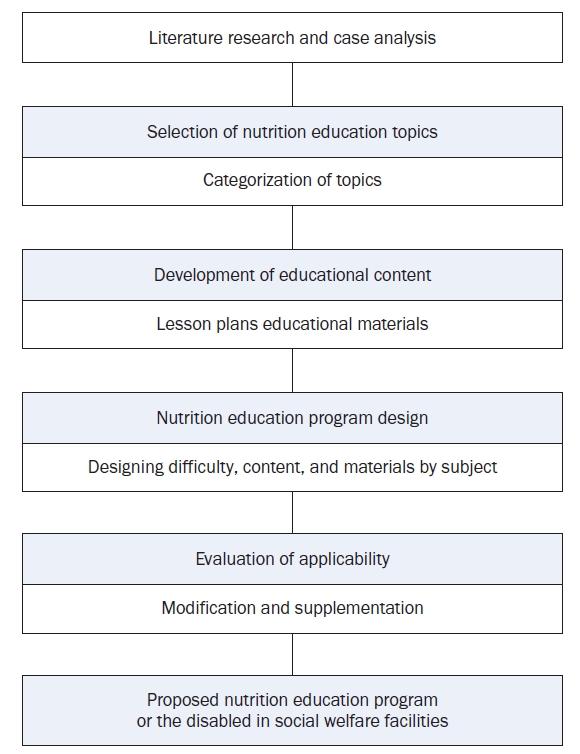
-
 Abstract
Abstract
 PDF
PDF PubReader
PubReader ePub
ePub - Objectives
This study aimed to develop a nutrition education program based on social cognitive theory to promote the health of individuals using facilities for people with disabilities. It also sought to evaluate the applicability of the educational materials through assessments by counselors at the Social Welfare Food Service Management Support Center.
Methods
A group of six experts developed the program based on a needs assessment of nutrition education in facilities for individuals with disabilities. Applicability was evaluated through an online survey of 26 counselors from Social Welfare Food Service Management Support Centers nationwide in July 2023, and the results were analyzed.
Results
The nutrition education program includes a basic course on personal hygiene, dining etiquette, picky eating prevention, and obesity management. The advanced course covers dietary management for chronic diseases, such as meal planning for hypertension, diabetes management, and dietary principles for dysphagia. Additionally, lecture PPTs, individual activity sheets, and experiential teaching aids were developed. Applicability evaluations showed high scores, with the teaching-learning plan and PPT averaging 4.15 and the experiential teaching aids scoring 4.17, all above 4.0.
Conclusion
This study developed a nutrition education program for individuals with disabilities and assessed its applicability and usability. Implementing this program in disability welfare institutions could enhance health promotion and improve the quality of life for individuals with disabilities.
- 1,557 View
- 60 Download

- [English]
- Nutrition quotient for preschoolers and key impacting factors in Korea: a cross-sectional study on food literacy, social support, and the food environment of primary caregivers
- Danbi Gwon, Ji-Yun Hwang, Jieun Oh
- Korean J Community Nutr 2025;30(1):16-26. Published online February 28, 2025
- DOI: https://doi.org/10.5720/kjcn.2024.00311
- Funded: Ministry of Food and Drug Safety
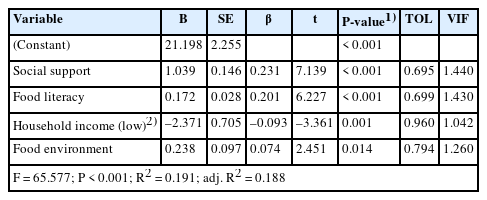
-
 Abstract
Abstract
 PDF
PDF PubReader
PubReader ePub
ePub - Objectives
This study evaluated the nutrition quotient for preschoolers (NQ-P) and analyzed the impact of key factors, such as caregivers’ food literacy, social support, and food environment, on the eating habits of preschool children in Korea. This study also sought to provide foundational data for developing tailored nutrition education programs by identifying the nutrition education needs of caregivers.
Methods
This study was conducted among caregivers of preschool children (aged 0–6 years) using an online self-administered survey conducted from August 22 to August 28, 2023. A total of 1,116 survey responses were analyzed. This study assessed children’s NQ-P score, caregivers’ food literacy, social support, food environment, and nutritional education needs. Data were analyzed using SPSS 29.0 (IBM Co.).
Results
The average NQ-P score for preschool children was 52, showing a tendency for the balance score to decrease and the moderation score to increase with age. Children from rural and low-income areas exhibited significantly lower NQ-P scores. Caregivers’ food literacy was higher in urban and higher-income groups. Multiple regression analysis revealed that social support, food literacy, income, and food environment significantly affected children's NQ-P scores. The effectiveness of nutrition education varied based on the income level, with nutrition education on healthy eating being the most preferred topic for preschool children.
Conclusion
This study confirmed that caregivers’ food literacy and social support significantly affected preschool children’s nutritional status. This suggests a need for tailored nutritional education and dietary support policies, particularly for low-income and rural populations.
- 1,396 View
- 48 Download

- [Korean]
- Analysis of pork consumption attribute factors by consumer lifestyle in Korea: a cross-sectional study
- Jounghee Lee, Juhyun Lee, Wookyoung Kim
- Korean J Community Nutr 2025;30(1):75-88. Published online February 28, 2025
- DOI: https://doi.org/10.5720/kjcn.2024.00332
- Funded: Korea Pork Checkoff Board
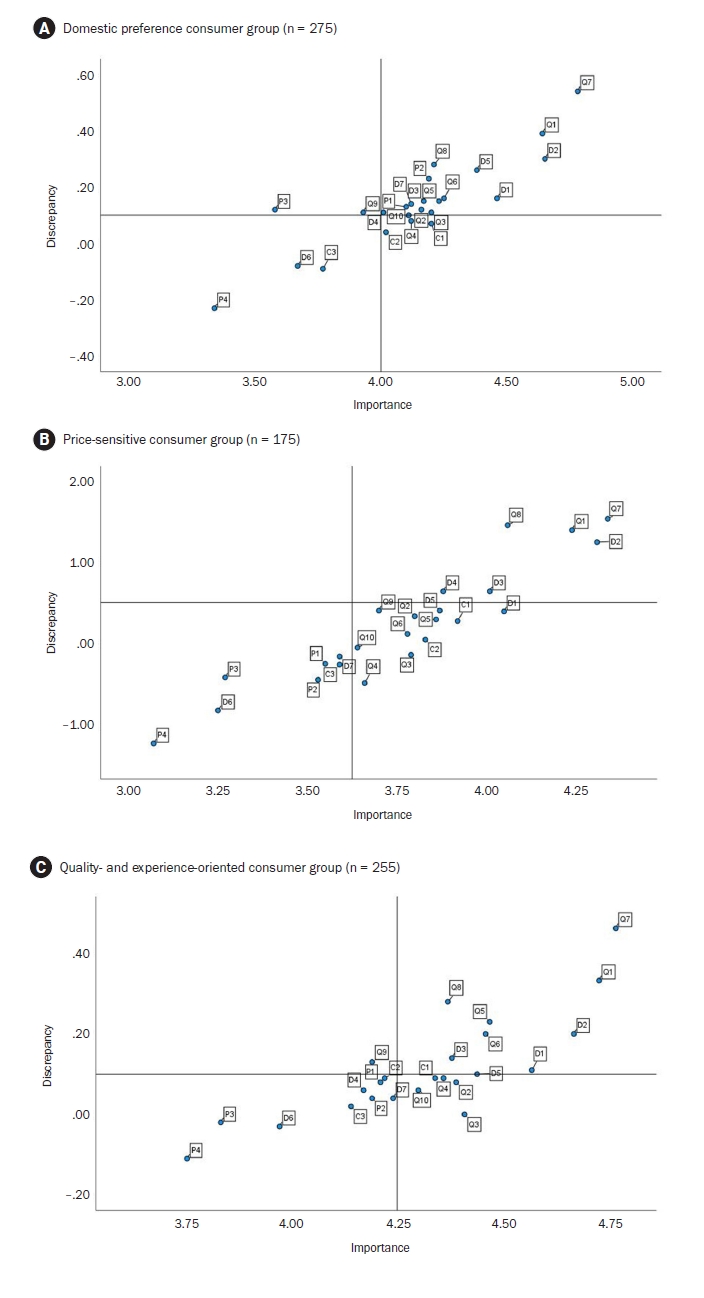
-
 Abstract
Abstract
 PDF
PDF PubReader
PubReader ePub
ePub - Objectives
This study aims to identify and analyze how different South Korean lifestyles impact attitudes towards pork consumption.
Methods
We implemented a cross-sectional survey targeting 705 adult consumers in South Korea using hierarchical and K-means cluster analyses. Respondents were classified into three relevant lifestyles: (1) domestic preference, (2) price-sensitive, and (3) quality-experience-oriented. The importance-performance analysis was employed to evaluate discrepancies between how they rated pork consumption using factors of “importance” and “satisfaction”. We employed Borich’s needs assessment and the Locus for Focus model to prioritize management areas.
Results
The research findings highlight that unpleasant odor/smell (Q7) and hygiene (Q1) were common key areas for management across all consumer groups, emphasizing their importance in enhancing pork consumption satisfaction. Among the groups, the domestic preference group showed high importance-performance discrepancies in attributes like expiry date (D2), suggesting a need for strengthened trust in domestic pork distribution and information transparency. The price-sensitive group prioritized economic factors, with fat thickness (Q8) identified as an essential management area. The quality-experience-oriented group emphasized sensory qualities such as juiciness (Q6) and meat color (Q5), with off-flavors (Q7) displaying the largest discrepancy. These results show the significant role of sensory attributes in consumer satisfaction.
Conclusion
This study demonstrated the multidimensional nature of pork consumption behavior, emphasizing the need for tailored strategies across consumer groups. Managing hygiene (Q1) and reducing off-flavors (Q7) are critical for all segments, while group-specific strategies include managing sensory quality for the quality-experience-oriented group, providing product information (D2) to increase trust for the domestic preference group, and emphasizing value for money for the price-sensitive group.
- 920 View
- 34 Download

- [Korean]
- Impact of a public health center nutrition education program on patients with type 2 diabetes in a primary care-based chronic disease management project: a pilot intervention study
- Haerim Yang, Yoo Kyoung Park, Ji-hyun Lee, Hee-Sook Lim, Heejoon Baek, Hyejin Lee, Haeran Park, Pyunghwa Lee, Jooyoun Chung, Won Gyoung Kim
- Korean J Community Nutr 2024;29(6):492-503. Published online December 31, 2024
- DOI: https://doi.org/10.5720/kjcn.2024.00018
- Funded: Korea Health Promotion and Development Institute
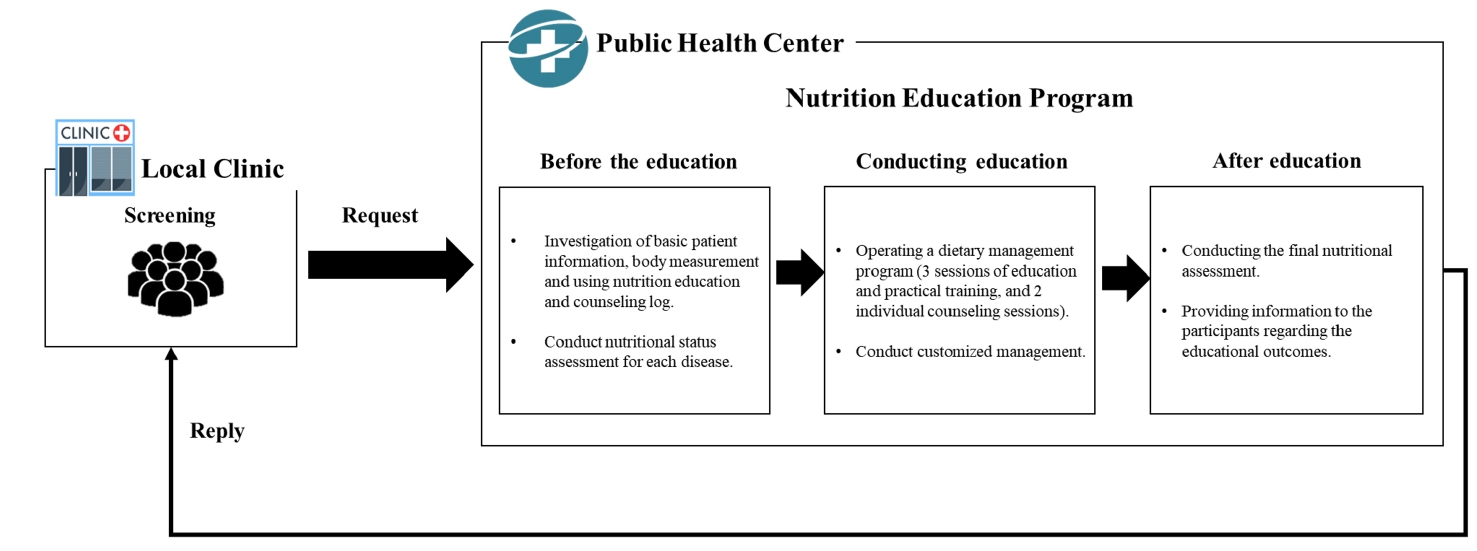
-
 Abstract
Abstract
 PDF
PDF PubReader
PubReader ePub
ePub - Objectives
We investigated the impact of an advanced “Nutrition Education Program” on patients with Diabetes mellitus, type 2 from public health centers enrolled in a primary health care-based chronic disease management project. This 12-week dietary management program was developed by the Korea Health Promotion and Development Institute. We assessed if this program improved glycemic control and other health indicators through dietary and nutritional improvements.
Methods
Seventeen patients with Diabetes mellitus type 2 were enrolled in the “Nutrition Education Program.” These patients were referred to public health centers for lifestyle management based on physician assessments at local clinics that were participating in a pilot project on primary health care-based chronic disease management. The participants attended the program comprising face-to-face basic, in-depth, and practical training sessions at the health center during the third, fifth, and seventh weeks, respectively. Anthropometric measurements, body composition analysis, blood biochemical characteristics, nutritional knowledge, and self-efficacy evaluation were performed before and after the program. Data were analyzed using SPSS ver. 28.0.
Results
The mean age of the participants was 62 years, and most participants were female (14, 82.4%). No significant changes in patients’ anthropometric measurements or body composition were observed after the training. However, significant reductions were observed in the blood biochemical characteristics, including glycated hemoglobin, total cholesterol, and low-density lipoprotein levels. Additionally, patients’ nutritional knowledge and self-efficacy scores increased significantly.
Conclusions
The “Nutrition Education Program” helped in improving glycemic control and other health indicators in patients with Diabetes mellitus type 2. Further research is required to objectively confirm the long-term and sustained effects of the program in a controlled study. Trial Registration Clinical Research Information Service Identifier: KCT0010010
- 1,397 View
- 60 Download

Research Note
- [English]
- A pilot investigation of a combined food literacy and exercise program for college students: a one-group pre-post intervention study
- Minjeong Jeong, Jinhyun Kim, Dahye Han, Eunjin Jang, Kyoungho Choi, Sohyun Park
- Korean J Community Nutr 2024;29(6):455-466. Published online December 31, 2024
- DOI: https://doi.org/10.5720/kjcn.2024.00248
- Funded: National Research Foundation of Korea
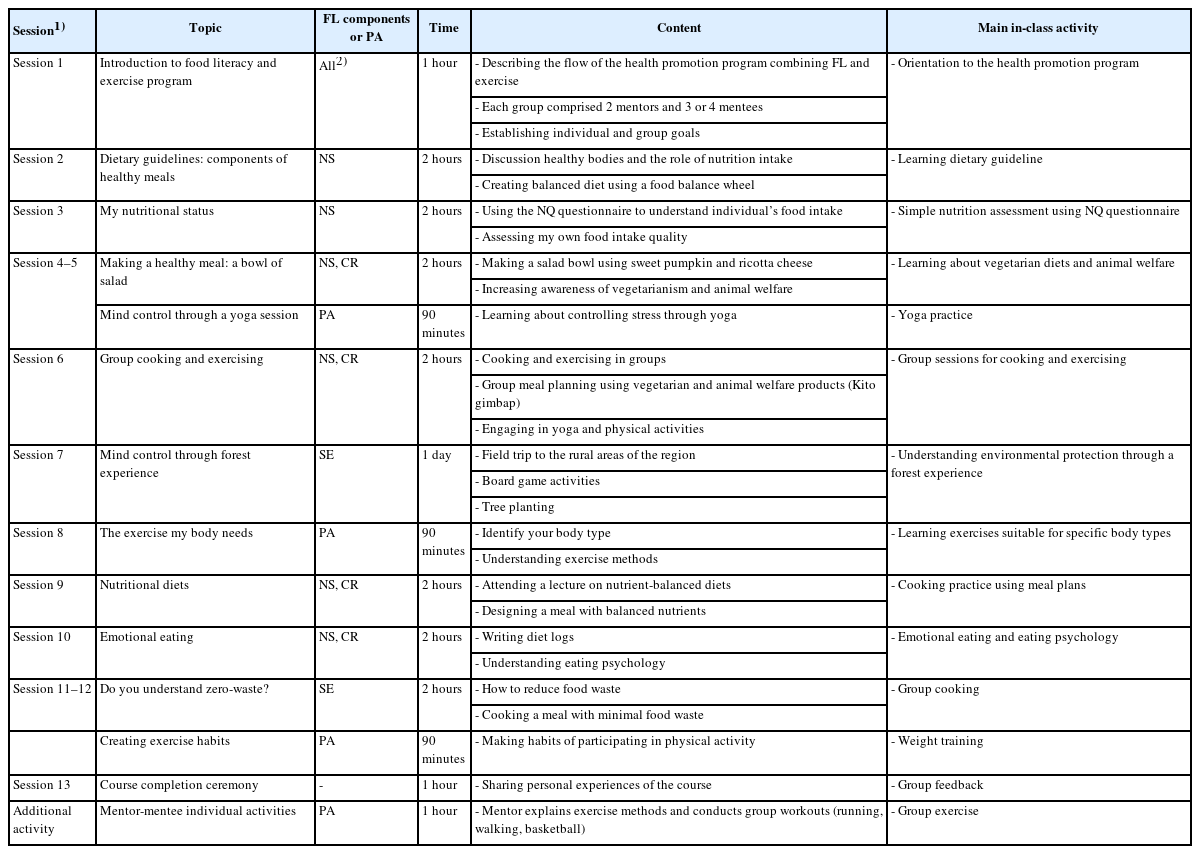
-
 Abstract
Abstract
 PDF
PDF PubReader
PubReader ePub
ePub - Objectives
A campus-based intervention to enhance food literacy (FL) and establish exercise habits among college students was developed and the program’s effectiveness was evaluated.
Methods
The 13-session program was developed based on the transtheoretical model and social cognitive theory. Junior and senior students majoring in food and nutrition and physical education were asked to participate as mentors, with freshmen and sophomores from varied majors as mentees. The program encompassed food, nutrition, and exercise lessons including cooking sessions. Data were collected via pre- and post-program surveys using a questionnaire consisting of items on FL and nutrition behaviors and physical fitness measurements.
Results
Among 39 participants (35.9% male, 64.1% female), the overall FL score increased significantly from 64.1 to 70.6 post-program (P = 0.001). Significant increases were observed in the nutrition and safety (P < 0.001), cultural and relational (P = 0.023), and socio-ecological (P = 0.001) domains, as well as knowledge (P = 0.001), self-efficacy (P = 0.013), attitude (P < 0.001), and behavior (P = 0.005) items in three domains of FL. Additionally, meal duration increased significantly (P = 0.007) and sit-up performance among female showed a meaningful change (P = 0.046). Changes in dietary behaviors significantly progressed (P = 0.015) while that in exercise habits approached a marginal significance (P = 0.053) after the intervention.
Conclusion
The results reveal positive changes in FL and some modifications in eating habits, although the program had limited effects on physical activity and fitness measurements. These findings suggest that strategic approaches to foster exercise behavior changes in college students are required. This pilot program can serve as foundational data for improving and expanding multicomponent health promotion programs for this population.
- 1,389 View
- 46 Download

Research Article
- [Korean]
- Co-occurrence network and pattern of school lunch using big data and text-mining using data from the 2021–2023 school meal menu information on the NEIS open educational information portal: an exploratory study
- Hyeyun Kang, Jimi Kim
- Korean J Community Nutr 2024;29(6):514-527. Published online December 31, 2024
- DOI: https://doi.org/10.5720/kjcn.2024.00297
- Funded: Changwon National University
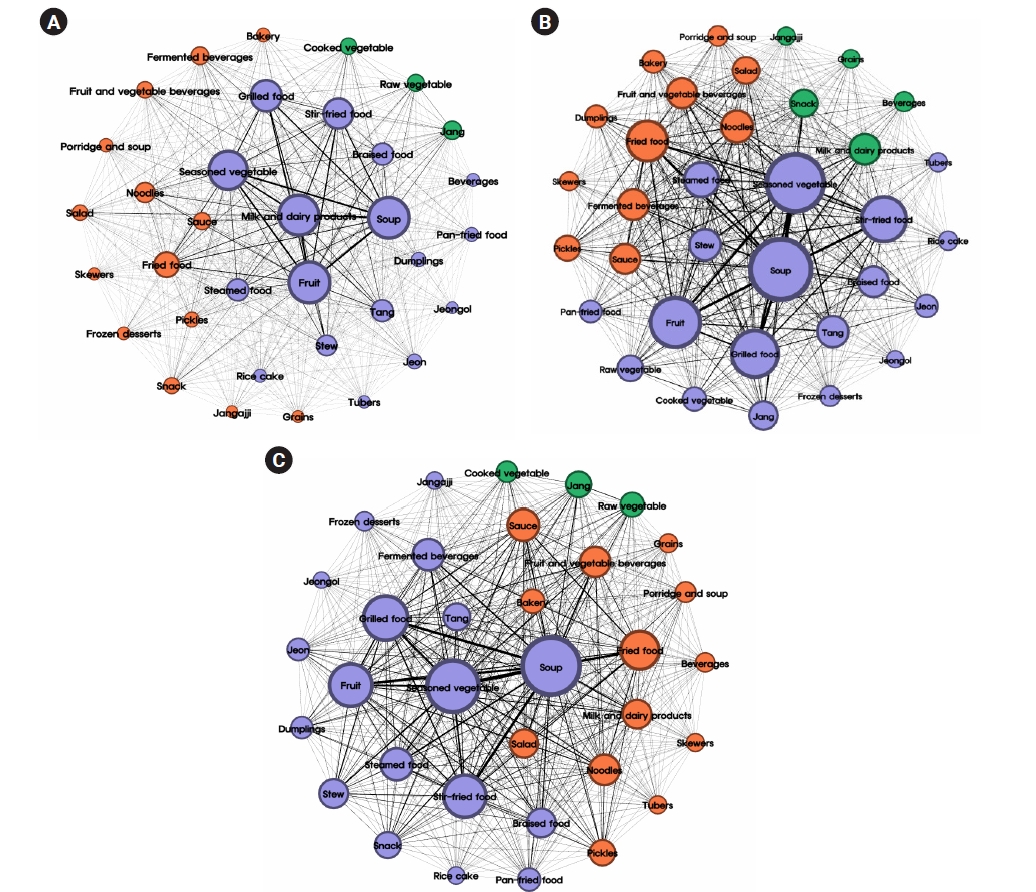
-
 Abstract
Abstract
 PDF
PDF Supplementary Material
Supplementary Material PubReader
PubReader ePub
ePub - Objectives
This study aimed to use big data from elementary, middle, and high school lunches to determine the primary food groups and menu items that contribute to lunch meals through text-mining and investigate the variations in food groups and menu composition patterns across different grade levels.
Methods
Between 2021 and 2023, a total of 7,892,456 lunch menus from 17 cities and provinces in South Korea were analyzed using big data from the National Education Information System (NEIS) system. After undergoing text preprocessing for text-mining, the collected menus were classified into 34 food groups based on primary ingredients and cooking methods, excluding the types of rice and kimchi. Subsequently, analyses of term frequency, term frequency-inverse document frequency (TF-IDF), centrality, and co-occurrence networks were performed on the food group and menu data.
Results
According to the TF-IDF, the most frequent food group across all grade levels was soup and seasoned vegetables, whereas milk was the most frequently provided menu. As the grade level increased, the frequency of grilled and fried food increased. In elementary schools, fruits exhibited the highest centrality, whereas soup had the highest centrality in middle and high schools. Co-occurrence frequency revealed that the soup-fruit combination was the most common in elementary schools, whereas soup and seasoned vegetables were most frequently paired in middle and high schools. The co-occurrence network of food groups and menus further indicated that menus regularly provided as standard meals and those frequently offered as special meals formed distinct communities.
Conclusion
This study investigated the food groups and menu provision patterns in school meals through text-mining techniques applied to large-scale school lunch. The findings may contribute in enhancing the quality of nutritional management, school foodservice, and menu composition of school meal programs.
- 1,179 View
- 49 Download

Review
- [English]
- Research trends relating to body weight control: a systematic review and keyword network analysis of Korea Citation Index Journals (2004–2023)
- Yunkyoung Oh, Eunsil Her
- Korean J Community Nutr 2024;29(6):445-454. Published online December 31, 2024
- DOI: https://doi.org/10.5720/kjcn.2024.00269
- Funded: Changshin University
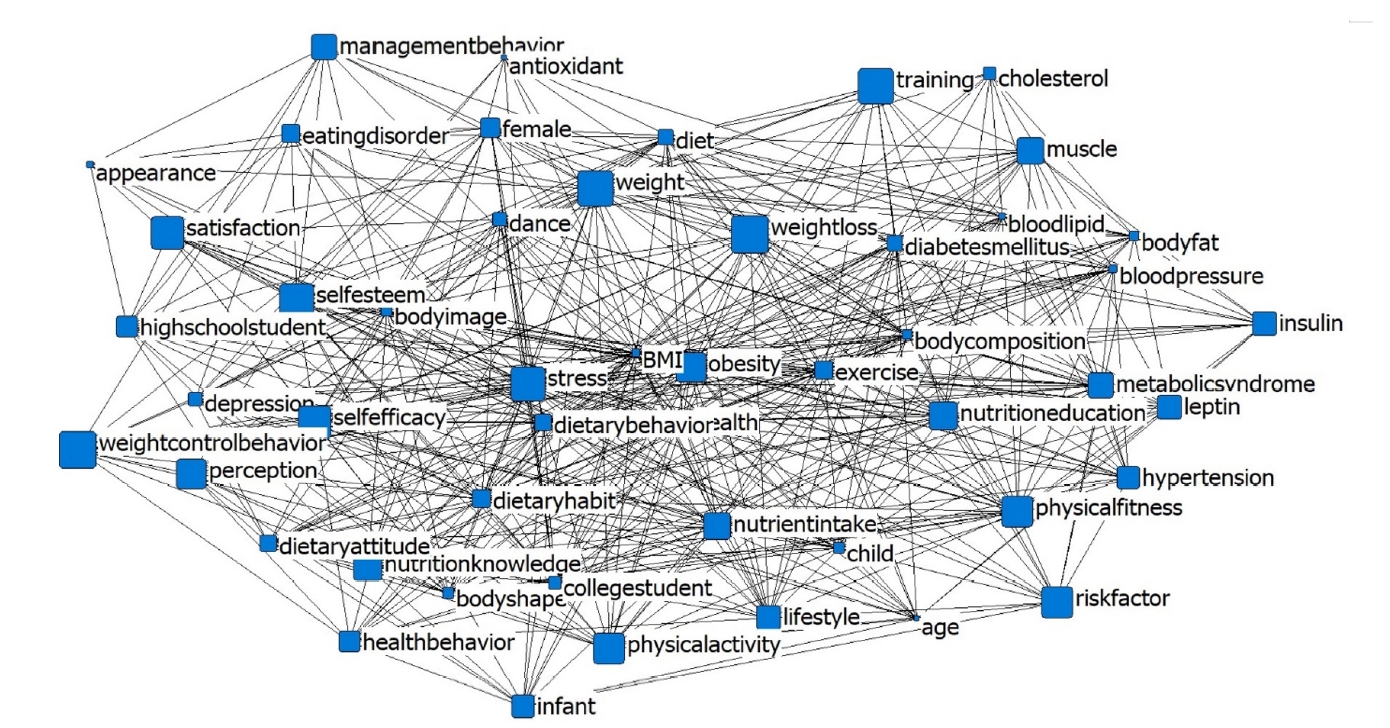
-
 Abstract
Abstract
 PDF
PDF PubReader
PubReader ePub
ePub - Objectives
Obesity rates are rapidly rising in Korea. Weight control is highly involved in obesity treatment. This study aimed to explore research trends related to weight control through keyword network analysis. By focusing on journals indexed in the Korea Citation Index (KCI), this study highlights trends specific to Korea, offering insights that reflect the country’s unique cultural and policy contexts in weight control research.
Methods
This study collected keywords from weight control-related papers published in the KCI journal over the past 20 years. Keywords were cleaned through Textom (2024), and the relationships between key research issue frequency analysis, structural characteristics, and keywords were identified using Textom, UCINET6, and NetDraw.
Results
Over the past 20 years, 40 to 50 studies related to weight control have been conducted each year. The Korean Journal of Community Nutrition had the largest number of published articles. Keyword frequency analysis showed that ‘obesity’ had the highest frequency. And the analysis of degree centrality and betweenness centrality, the keyword ‘obesity’ ranked the highest. CONCOR analysis identified four clusters: preventive health care, health management, physical health, and personal development.
Conclusion
The results of this study showed that weight control research reflecting the characteristics of the times has been steadily progressing in relation to the rapidly increasing obesity in Korea, and when developing policies or setting research directions related to weight loss in the future, research should be conducted in a prospective manner by subdividing it according to groups and interests.
- 1,386 View
- 37 Download

Research Articles
- [Korean]
- Development and application of a dietary program to reduce sugar intake using a living lab approach in Korea: an intervention study
- Jung-Hyun Kim, Min Sook Kyung, Seul Ki Choi
- Korean J Community Nutr 2024;29(6):504-513. Published online December 31, 2024
- DOI: https://doi.org/10.5720/kjcn.2024.00318
- Funded: Ministry of Food and Drug Safety of Korea
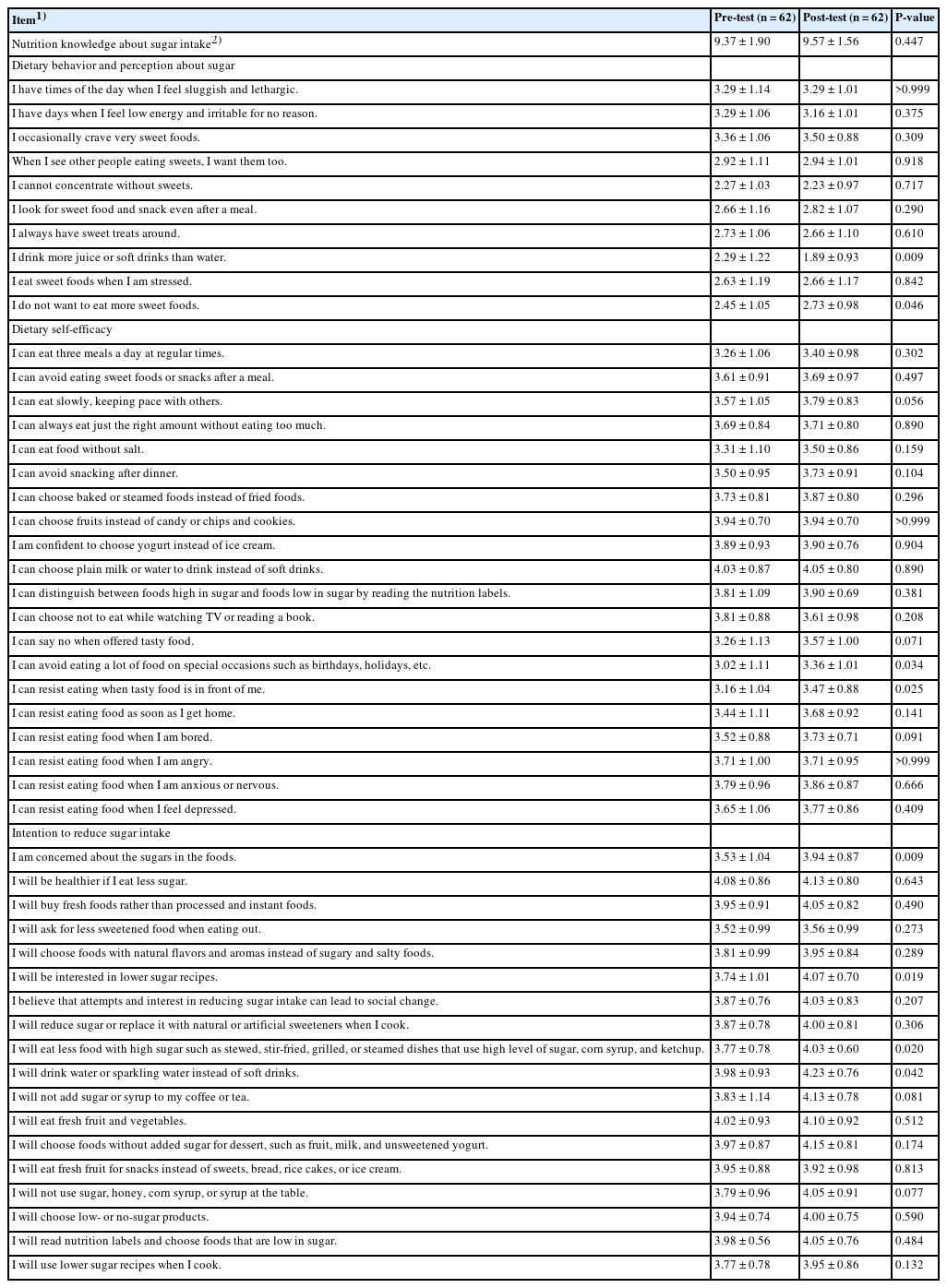
-
 Abstract
Abstract
 PDF
PDF PubReader
PubReader ePub
ePub - Objectives
This study aimed to develop and apply a dietary program to reduce sugar intake among community residents using a Living Lab approach.
Methods
We developed and applied a community-based dietary program to reduce sugar intake. Participants were recruited from community organizations, including a children’s food service management center, elementary to high schools, a university, a family center, a community health center, and an elderly welfare center. The dietary program was conducted in two phases; start and next levels. The start level included a pre-assessment of dietary behaviors and participation in educational platforms, whereas the next level included activities using educational platforms, tailored mission and feedback, and pre- and post-surveys. Extension educators at each community organization implemented the dietary program following organization-specific guidelines. Changes in participants’ nutrition knowledge, dietary behaviors and perceptions, self-efficacy, intention to reduce sugar intake, and participants’ program satisfaction were analyzed using paired t-tests.
Results
In total, 1,238 and 339 individuals participated in the start and next level, respectively. Participants reported significantly lower scores on dietary behavior items regarding drinking more juice or soft drinks after program participation (P = 0.009) and craving sweet foods (P = 0.046). They reported a higher intention to take interest in sugar content in food (P = 0.009) and lower-sugar recipes (P = 0.019), eat less food with high sugar content (P = 0.020), and drink water or sparkling water instead of soft drinks (P = 0.042). Nutrition knowledge did not significantly change after program participation. Program satisfaction significantly increased from the start level to the next level (P<0.050).
Conclusion
This study showed the potential of using a Living Lab approach to implement community-wide dietary interventions. Further research is required to evaluate the effectiveness of the Living Lab approach in various community settings.
- 1,258 View
- 53 Download

- [English]
- Trends in growth and nutritional status of Korean toddlers and preschoolers: a cross-sectional study using 2010–2021 Korea National Health and Nutrition Examination Survey data
- Annisa Turridha, Jae Eun Shim
- Korean J Community Nutr 2024;29(6):480-491. Published online December 31, 2024
- DOI: https://doi.org/10.5720/kjcn.2024.00241
- Funded: Daejeon University
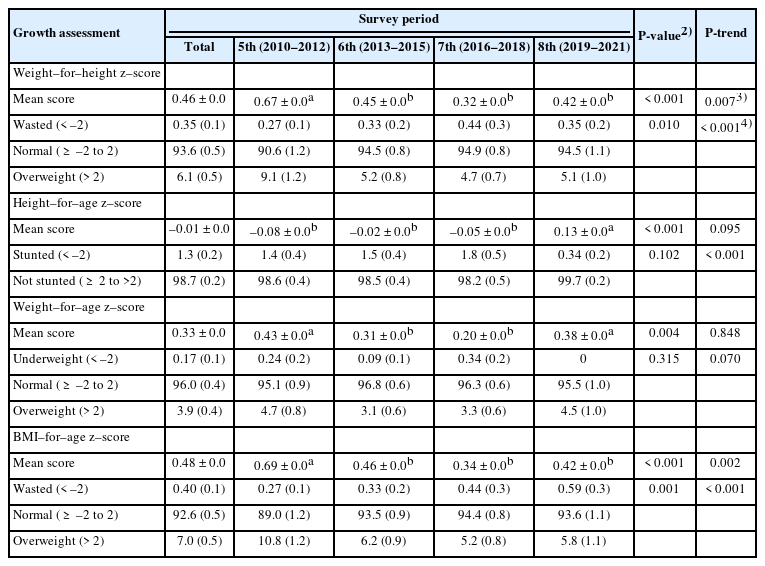
-
 Abstract
Abstract
 PDF
PDF PubReader
PubReader ePub
ePub - Objectives
We aimed to analyze trends in growth and nutrient intake patterns in Korean toddlers and preschoolers and generate data for international comparisons of early childhood growth status.
Methods
Overall, 3,661 children aged 1–4 years were included. This study used the data from the 5th–8th Korea National Health and Nutrition Examination Survey. The weight-for-height, height-for-age, weight-for-age, and body mass index-for-age z-scores of the participants were calculated using the World Health Organization 2006 child growth z-score reference cutoff points. The 24-hour recall method was used to determine dietary intake, which was assessed according to the Dietary Reference Intake for Koreans. All statistical analyses were conducted and weighted according to a complex sample design.
Results
Most Korean toddlers and preschoolers demonstrated normal growth, with an increasing trend noted over the survey period. Concurrently, the prevalence of overweight decreased. The mean intake of energy from fat exhibited an upward trend, paralleling that of protein and fat. Conversely, the intake of several essential micronutrients declined. The prevalence of nutritional inadequacy showed significant variation throughout the survey period; the proportion of inadequacy in carbohydrate intake decreased, whereas those of iron, vitamin A, thiamin, niacin, and vitamin C increased.
Conclusion
South Korea is making significant progress in supporting toddlers and preschoolers, as evidenced by consistent increases in the proportion of children with normal growth and decreases in the prevalence of malnutrition. Future research should focus on exploring dietary patterns and analyzing specific food groups that are essential for promoting optimal growth and nutritional status in children.
- 2,316 View
- 48 Download

- [English]
- Nutritional content and healthiness in sweet and salty snacks and beverages popular in South Korea and the United States assessed by nutrition labels: a cross-sectional comparative study
- Bo Jeong Gong, Segovia Lucas, Diewo Camara, Pauline E. Jolly, Chandrika Piyathilake, Taisun Hyun
- Korean J Community Nutr 2024;29(6):467-479. Published online December 31, 2024
- DOI: https://doi.org/10.5720/kjcn.2024.00290
- Funded: National Institute of Minority Health and Health Disparities
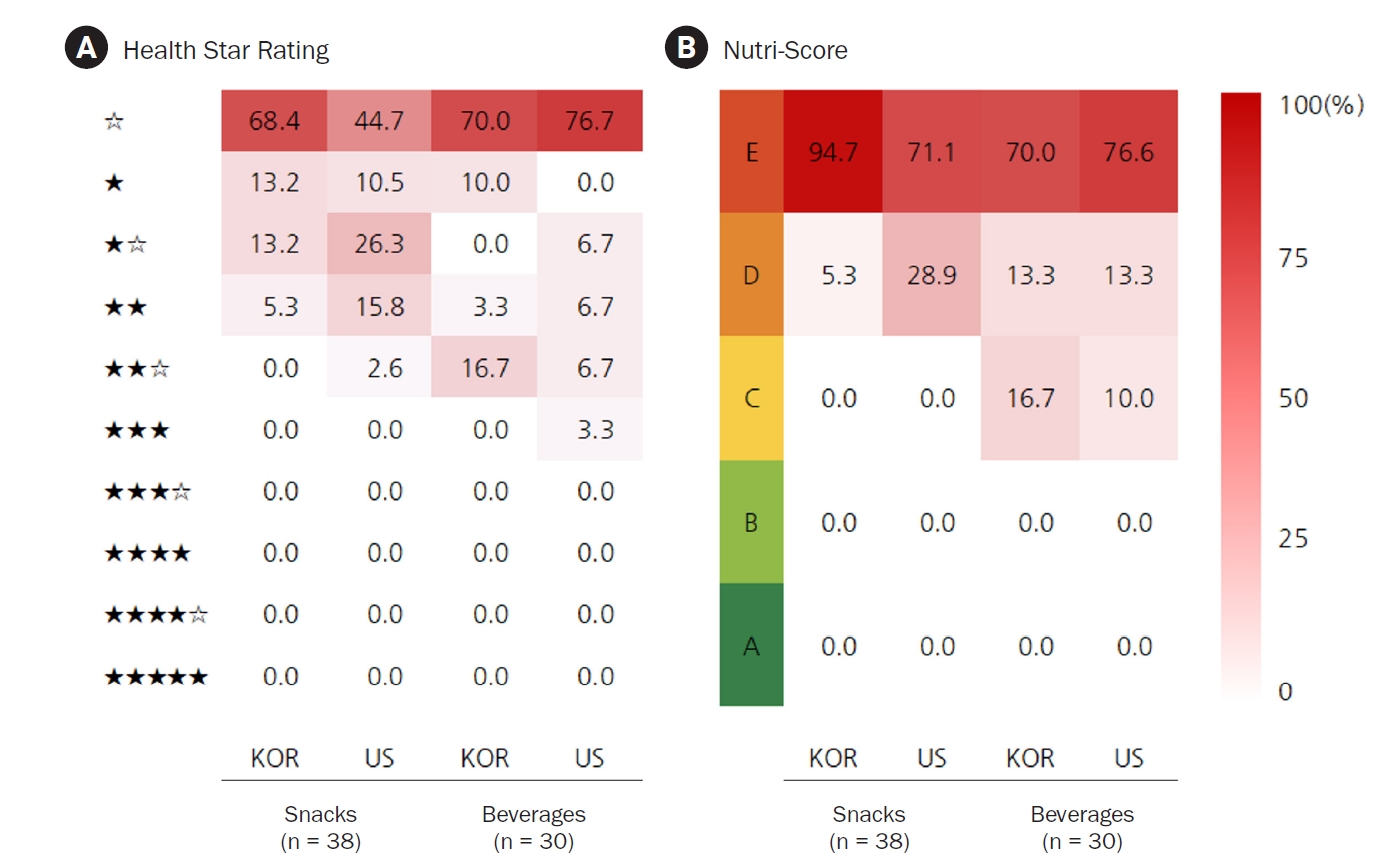
-
 Abstract
Abstract
 PDF
PDF PubReader
PubReader ePub
ePub - Objectives
This study investigated the nutritional differences between sweet and salty snacks and beverages in South Korea (Korea) and the United States (US). Nutritional content and healthiness were determined using back- and front-of-package nutrition labeling (FoPNL) systems.
Methods
Three snack and three beverage categories popular in Korea and the US were selected. Statistical data were used to determine the top 10–15 best-selling products in each category in each country. The selected products included chips (n = 15), cookies (n = 10), chocolate (n = 13), carbonated drinks (n = 10), fruit juices/drinks (n = 10, 5/5), and energy drinks (n = 10). The study excluded products that were artificially sweetened. Nutritional information and percentages of fruit and vegetable content in each product were collected from brand websites and grocery stores in each country. The FoPNL system was used to assess the healthiness of the products, which included multiple traffic light labels, a Health Star Rating, and a Nutri-Score.
Results
Overall, Korean snacks contained significantly more protein, total fat, saturated fat, and cholesterol than US snacks. However, the US chips and carbonated drinks contained more sodium, while the US energy drinks contained more caffeine than Korean products. The serving size of US carbonated drinks was significantly larger than that of Korean drinks, whereas the serving size of US chips was smaller than that of Korean products. The FoPNL system classified the majority of products as ‘less healthy.’
Conclusion
Our results suggest that Korean and US food manufacturers should improve the nutritional quality and/or serving size of commonly consumed food products. Policymakers in both countries should work to improve the presentation of ingredient and nutrient information on nutritional labels to assist consumers in making healthier food choices.
- 3,245 View
- 43 Download

- [Korean]
- The needs and prioritization of nutrition and dietary support for individuals with disabilities: an exploratory study
- Jong Eun Park, Yu Jin Kim, So Young Kim, Jong Hyock Park
- Korean J Community Nutr 2024;29(5):431-443. Published online October 31, 2024
- DOI: https://doi.org/10.5720/kjcn.2024.00009
- Funded: Ministry of Education, Ministry of Education, Ministry of Science and ICT
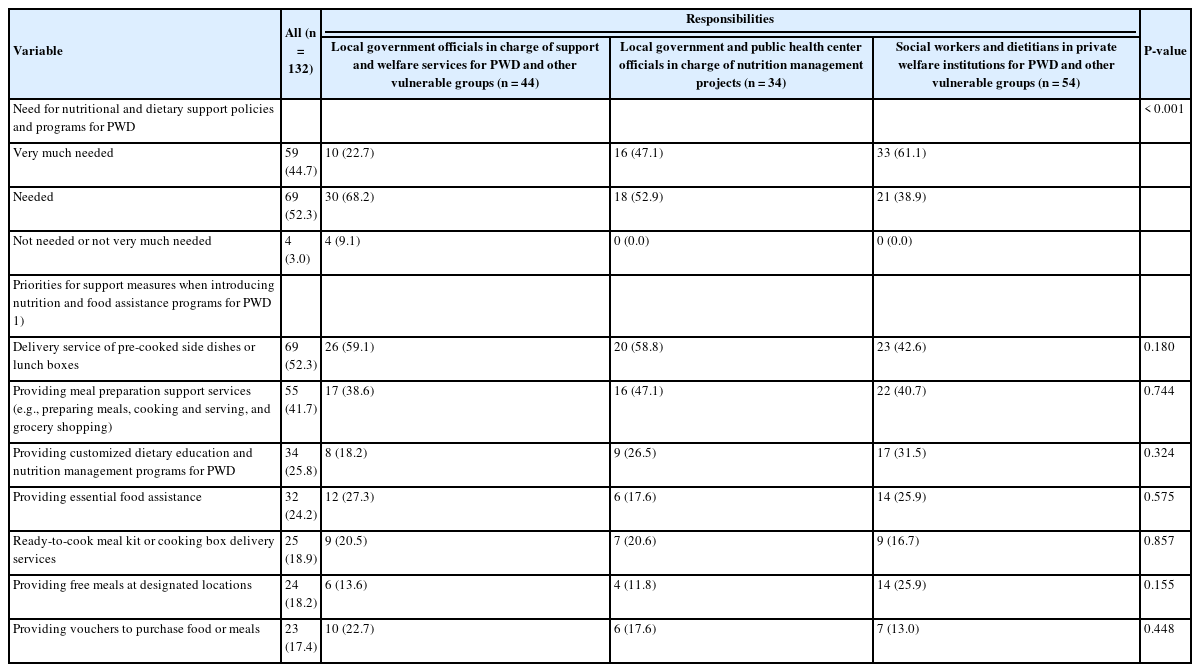
-
 Abstract
Abstract
 PDF
PDF PubReader
PubReader ePub
ePub - Objectives
Based on a survey of officers, social workers, and dietitians involved in managing nutrition and welfare policies or projects for vulnerable groups in local governments or private welfare institutions, this study aimed to assess the need for nutritional and dietary support policies and programs for persons with disabilities (PWD), as well as to identify appropriate support measures. Methods: An online survey was conducted from March 2 to 15, 2021. The survey included 20 questions exploring perspectives on the nutritional status of PWD, their need for nutritional and dietary support policies and programs, and the prioritization of appropriate support measures. A total of 132 responses were analyzed. Results: Approximately 68.9% of the respondents rated the nutritional status of PWD as “bad” or “very bad.” A substantial number identified “difficulty in purchasing ingredients, cooking, and preparing meals independently due to disability,” and “limited knowledge about nutrition and recipes necessary for maintaining a healthy and balanced diet” as the primary challenges in the dietary and nutritional management of this population. Additionally, 97.0% of the respondents deemed that the introduction of nutritional and dietary support policies and programs for PWD was “needed” or “very much needed.” Priority strategies to implement and strengthen these policies and systems included the “development of customized programs and services tailored to the needs and demands of the target population” and the “establishment of a dedicated department with specialized personnel.” Conclusion: Comprehensive nutritional and dietary support policies and programs should be actively implemented to ensure a healthy and stable diet for PWD, tailored to meet their actual needs and demands.
- 1,650 View
- 100 Download

- [English]
- Outcome expectations, self-efficacy, eating environment, and eating behaviors by the stages of change in adequate sodium intake among university students: a cross-sectional study
- Yeon Gyu Im, Kyung Won Kim
- Korean J Community Nutr 2024;29(5):382-395. Published online October 31, 2024
- DOI: https://doi.org/10.5720/kjcn.2024.00010
- Funded: Seoul Women`s University

-
 Abstract
Abstract
 PDF
PDF PubReader
PubReader ePub
ePub - Objectives
This study investigated whether outcome expectations, self-efficacy, eating environment, and eating behaviors differed according to the stages of change in adequate sodium intake among university students. Methods: The participants were students recruited from nine universities in Seoul, Korea. An online survey was conducted, and data from 351 participants were analyzed. Participants were classified into pre-action and action stages based on adequate sodium intake. Data were analyzed using t-test, χ2-test, analysis of covariance, and correlation analysis. Results: Participants in the action stage (22.8%) felt fewer disadvantages of eating sodium adequately compared to those in the pre-action stage (77.2%, P < 0.001) and perceived more self-efficacy for healthy eating behaviors (P < 0.001) and controlling sodium intake (P < 0.01). The participants in the action stage also showed more desirable eating behaviors than those in the pre-action stage, including general eating behaviors, behaviors related to sodium intake, and sodium checks (P < 0.001). The physical environment in the action stage was more supportive of adequate sodium intake (P < 0.05). Eating behaviors, self-efficacy, and outcome expectations were significantly correlated with the stages of change; however, some differences were noticed in the correlation of the subscales of variables with the stages of change when examined by sex. Conclusion: We observed differences in factors according to the stages of change in adequate sodium intake. For the pre-action stage, nutrition education can be planned to modify negative expectations of eating adequate sodium, foster self-efficacy, and practice general eating behaviors and behaviors to gradually reduce sodium intake. It is also necessary to alter the physical environment to reduce sodium intake. In the action stage, support and reinforcement are needed to continually practice and maintain desirable eating behaviors. Nutrition education for women may be planned using multiple paths, whereas a simple strategy may be useful for men.
- 1,959 View
- 42 Download

- [Korean]
- Food purchase patterns, food policy recognition, and food environment satisfaction among adults in Jeju, Korea, according to food security: a cross-sectional study
- Sumin Kim, Youjeong Jang, Hyunji Ham, Hanbin Ko, Insuk Chai, Kyungho Ha
- Korean J Community Nutr 2024;29(5):406-417. Published online October 31, 2024
- DOI: https://doi.org/10.5720/kjcn.2024.00012
- Funded: Jeju Special Self-Governing Province
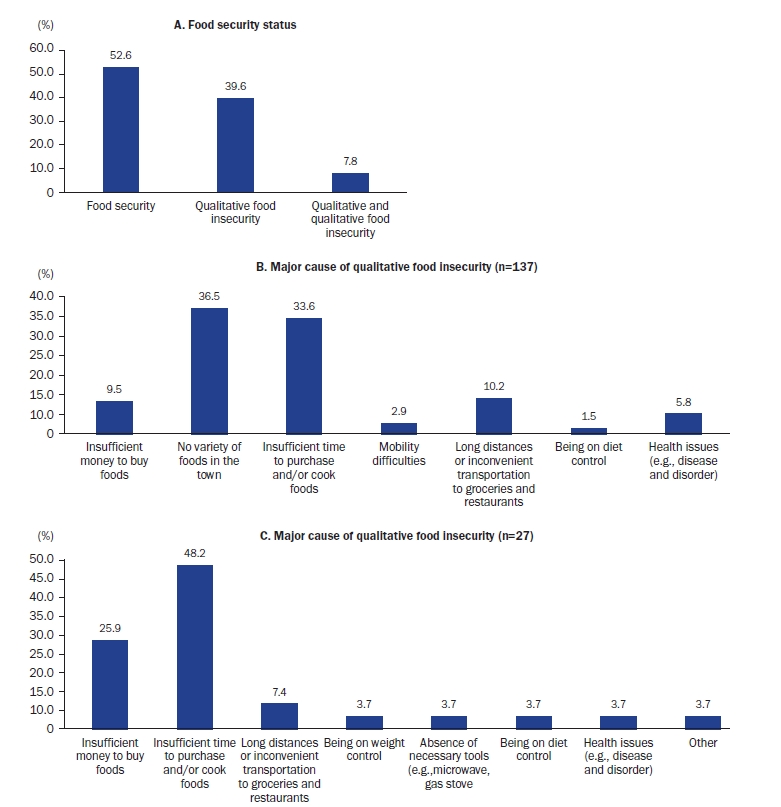
-
 Abstract
Abstract
 PDF
PDF Supplementary Material
Supplementary Material PubReader
PubReader ePub
ePub - Objectives
Recently, food insecurity has been a major public health issue along with the food crisis caused by COVID-19, climate change, and the polarization of food supply due to socioeconomic disparities. Food insecurity is known to be related to the food choices and environment of the consumer. Therefore, this study aimed to evaluate the food security statuses of adults in Jeju and investigate their food purchase patterns, food policy recognition, and food environment satisfaction.
Methods
Based on data from the 2022 Jeju Food Survey, 346 adults aged ≥19 years in Jeju were classified into food security and insecurity groups (quantitatively and qualitatively) using the questionnaire. Food purchase patterns, including purchasing frequency, items, and reasons, were surveyed for local and eco-friendly foods. The recognition and necessity of several food policies and satisfaction with diet and food environment (availability, accessibility, affordability, accommodation, and acceptability) were measured using the Likert scale.
Results
Among the total participants, 47.4% were in the food insecurity group. The frequency of purchasing local and eco-friendly foods did not significantly differ by food security status. The insecurity group exhibited a higher recognition rate of basic rights to food (36.0%) than the security group (24.7%, P = 0.023). The recognition and necessity of specific food policies did not significantly differ by food security status, except for the policy of promoting food communities, for which the food security group exhibited higher recognition than the food insecurity group did (P = 0.004). The food insecurity group exhibited significantly lower scores regarding satisfaction toward diet and food environment factors (P < 0.05 for all).
Conclusions
Overall, the food security group reported higher satisfaction with their diet and food environment than the food insecurity group. Further in-depth studies to investigate the determinants of food insecurity and effective promotional strategies for food policies are needed.
- 1,441 View
- 48 Download

- [English]
- Health-related quality of life and nutrient intake of the elderly with type 2 diabetes according to comorbidity burden: a cross-sectional study
- Yejung Choi, Kyong Park
- Korean J Community Nutr 2024;29(5):418-430. Published online October 31, 2024
- DOI: https://doi.org/10.5720/kjcn.2024.00014
- Funded: Yeungnam University, National Research Foundation of Korea
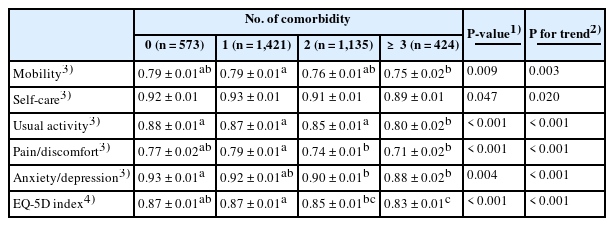
-
 Abstract
Abstract
 PDF
PDF PubReader
PubReader ePub
ePub - Objectives
This study aimed to explore the cross-sectional association between health-related quality of life (HRQoL) according to the number of comorbidities in older adults with type 2 diabetes mellitus (T2DM) using the Euro Quality of Life-5 Dimensions (EQ-5D) index. Methods: This study included 3,553 participants aged ≥ 65 years from the 2008–2020 Korea National Health and Nutrition Examination Survey. Dietary data were collected through 24-hour recall interviews by trained researchers, and demographic and lifestyle information via self-administered questionnaires. HRQoL was measured using a modified EQ-5D scale. Multivariable linear regression analyzed the associations between EQ-5D scores, nutrients and comorbidity, controlling for sociodemographic and health variables. Results: Most participants reported ‘no problems’ in the EQ-5D scores, although approximately 17% to 47% of participants reported ‘some problems’ or ‘extreme problems,’ depending on the dimension. As comorbidities increased, significant declines were observed across all dimensions, particularly in mobility, usual activities, pain/discomfort, and anxiety/ depression. Nutrient intake analysis revealed that participants with three or more comorbidities consumed less carbohydrates, but more fat. Conclusion: Our findings demonstrate that among older adults with T2DM, a higher number of comorbidities is associated with decreased HRQoL. Additionally, there are differences in nutrient intake patterns among those with more comorbidities, specifically decreased carbohydrate intake and increased fat intake. These results emphasize the need for comprehensive and tailored management strategies that consider both diabetes and the co-occurring health conditions. By addressing the complex healthcare needs of individuals with multiple comorbidities, it is possible to enhance their HRQoL and overall well-being.
- 1,285 View
- 26 Download

- [English]
- Eating habits and dietary supplement utilization according to food-related lifestyle among Korean adults: a cross-sectional study
- EunJung Lee, Jin A Jang, Ji-Myung Kim
- Korean J Community Nutr 2024;29(4):253-264. Published online August 31, 2024
- DOI: https://doi.org/10.5720/kjcn.2024.00017
- Funded: Hankyong National University
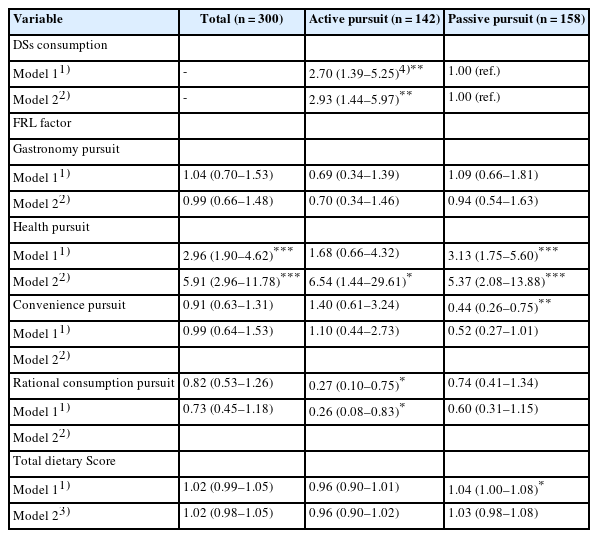
-
 Abstract
Abstract
 PDF
PDF PubReader
PubReader ePub
ePub - Objectives
This study investigated the association between eating habits and the utilization of dietary supplements (DSs) according to food-related lifestyle (FRL) among Korean adults. Methods: This study included a total of 300 participants (150 men and 150 women) in their 20s to 60s living in Seoul and Gyeonggi Province. We identified two groups by factor and cluster analysis: an ‘active pursuit’ group and a ‘passive pursuit’ group. Differences in eating habits and DS utilization between the two groups were analyzed by chi-square test and t-test. Logistic regression analysis was used to analyze the effect of variables on DS consumption according to FRL. Results: There were significant differences between the two groups in terms of age, alcohol drinking frequency, total dietary score, change in DS consumption after coronavirus disease 2019, and current DS consumption (P < 0.05). The proportion who perceived many health benefits of DSs was higher in the ‘active pursuit’ group than in the ‘passive pursuit’ group (P = 0.003). The most commonly consumed type of DSs was multivitamins & minerals for the ‘active pursuit’ group, and omega-3 fatty acids for the ‘passive pursuit’ group. The ‘an active pursuit’ group consumed DSs 2.93 times more (95% confidence interval [CI]: 1.44–5.97) compared to the ‘passive pursuit’ group, after adjusting for confounders. In the ‘active pursuit’ group, the health pursuit (odds ratio [OR] = 6.54, 95% CI: 1.44– 29.61) and rational consumption pursuit factors (OR = 0.26, 95% CI: 0.08–0.83) were associated with DS consumption, whereas only the health pursuit factor had a significant association (OR = 5.37, 95% CI: 2.08–13.88) within the ‘passive pursuit’ group. However, total dietary score and DSs consumption did not show a relationship. Conclusions: By understanding the consumption characteristics of DSs according to FRL, this can serve as basic data necessary for promoting health through the utilization of DSs and healthy behaviors. -
Citations
Citations to this article as recorded by- Discovering Vitamin-D-Deficiency-Associated Factors in Korean Adults Using KNHANES Data Based on an Integrated Analysis of Machine Learning and Statistical Techniques
Hongryul Ahn, Seungwon Kim, Jinmyung Jung, Chan Park
Nutrients.2025; 17(4): 618. CrossRef
- Discovering Vitamin-D-Deficiency-Associated Factors in Korean Adults Using KNHANES Data Based on an Integrated Analysis of Machine Learning and Statistical Techniques
- 2,509 View
- 85 Download
- 1 Crossref

- [English]
- Analysis of health behavior changes among residents in depopulation areas in Korea: a cross-sectional study based on Community Health Survey data from 2010 to 2019
- Miyong Yon
- Korean J Community Nutr 2024;29(4):348-357. Published online August 31, 2024
- DOI: https://doi.org/10.5720/kjcn.2024.00001
- Funded: Korea Disease Control and Prevention Agency
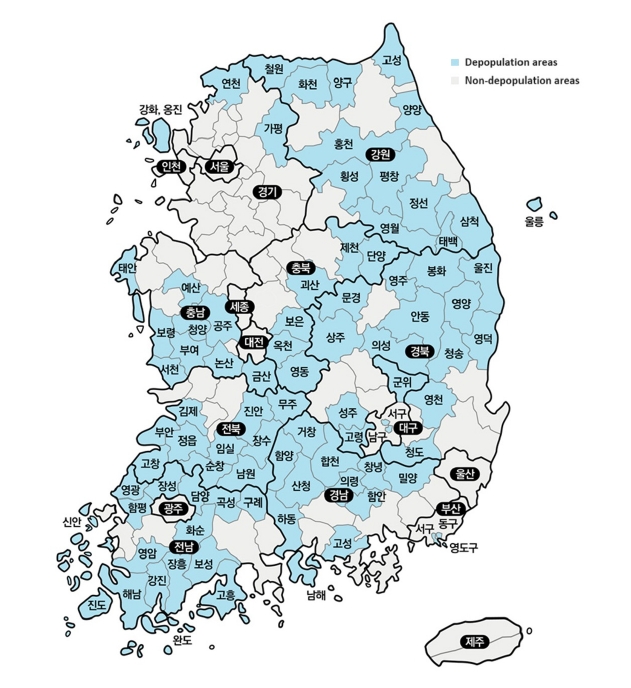
-
 Abstract
Abstract
 PDF
PDF PubReader
PubReader ePub
ePub - Objectives
The total population of Korea began to decline in 2019; in particular, the population in rural areas has been rapidly decreasing and is aging. Therefore, the government has designated depopulation areas and is seeking ways to support them. To assess whether health disparities exist between areas with population decline and those without, this study used community health survey data to observe temporal changes in health behaviors between the two types of areas. Methods: The analysis used Community Health Survey data from 2010 to 2019, and regional classification was divided by depopulation areas designated by the Ministry of the Interior and Safety. Trends in health behavior and chronic disease prevalence between depopulation and non-depopulation areas were analyzed. All analyses were conducted using complex sample analysis procedures in SAS 9.4 software. Results: The smoking rate steadily decreased in both depopulation and non-depopulation areas, whereas the high-risk drinking rate increased slightly. The walking practice rate did not improve in depopulation areas compared to non-depopulation areas. Furthermore, nutritional labeling usage rate was consistently lower in depopulation areas than in non-depopulation areas, with the gap being the largest. The prevalence of obesity, diabetes, and hypertension showed that the gap between depopulation and non-depopulation areas is continuously increasing. Conclusions: Health behaviors in depopulation areas have not improved, and the prevalence of chronic diseases is increasing rapidly. Therefore, the demand for health care services that support healthy lifestyle practices and chronic disease management in these areas is expected to increase.
- 1,421 View
- 20 Download


 KSCN
KSCN

 First
First Prev
Prev



